Sonova USA ICOM1 Wireless Fitting Device User Manual
Phonak Inc Wireless Fitting Device
User Manual
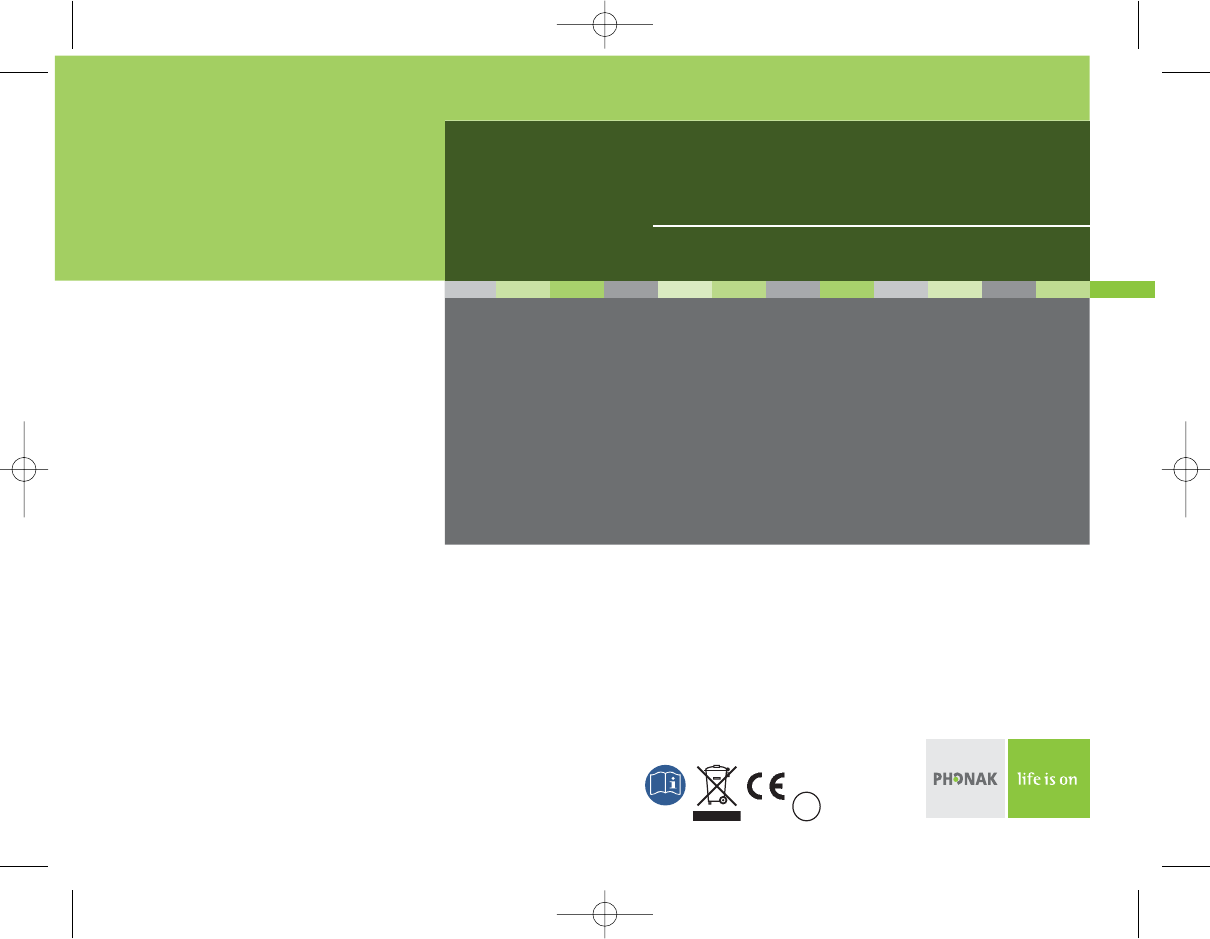
User Guide
iCom™
Your hearing care professional
029-0692-02/V1.00/2007-12/A+W
Printed in Switzerland © Phonak AG All rights reserved
www.phonak.com 0682 !
GA_iCom_GB.qxp 4.1.2008 14:12 Uhr Seite 1

23
Contents
Welcome 6
Description 8
iCom accessories 9
Getting Started 10
Charging the battery 10
Operating time 11
Battery status 12
Turning your iCom ON or OFF 12
Wearing your iCom 14
Checking the connection to your
hearing instruments 15
Indicators cover 16
Introduction to Bluetooth 17
What is Bluetooth? 17
What Bluetooth devices
can I use with my iCom? 17
Bluetooth device compatibility 18
Bluetooth operating range 19
Using a Bluetooth device 20
GA_iCom_GB.qxp 4.1.2008 14:12 Uhr Seite 2

5
4
Contents
Start streaming 42
Pause streaming 43
Stop streaming 43
Streaming interruptions 44
Reset button 45
Indicators 46
Important information 54
Maintenance and care 54
Safety notice 55
Important points 56
Troubleshooting 58
myPilot (optional) 64
Service and warranty 67
Declaration of conformity 68
Phonak distributors worldwide 70
Setting up Bluetooth devices 21
Pairing with your mobile phone 21
Connecting your mobile phone 23
Pairing and connecting iCom with a Bluetooth
transmitter 24
Pairing and connecting iCom with a Personal
Computer (PC) 26
Deleting Bluetooth pairings 28
Using your iCom with your mobile phone 29
How your iCom interacts with your
mobile phone 29
Speaking into your iCom 31
Moving out of Bluetooth range 32
Incoming calls 32
Accepting incoming calls 33
Rejecting incoming calls 34
Making a call 34
Ending a call 36
Using audio devices and FM 37
Streaming priorities 37
Connecting via audio cable (3.5 mm jack) 38
Connecting via Bluetooth 39
Connecting an FM system 40
GA_iCom_GB.qxp 4.1.2008 14:12 Uhr Seite 4

67
Congratulations on choosing the iCom from Phonak.
iCom expands the ways in which you hear your world
by wirelessly connecting your hearing instruments to
your mobile phone, portable MP3 player, personal
computer and many other devices.
Please read this manual carefully to benefit from
all the features of your iCom. Ask your hearing care
professional if you have any questions.
For further information, please visit the Phonak
website www.phonak.com.
Phonak – life is on
For your safety, carefully read the chapter
Important information, on pages 54 – 63.
What is the iCom?
iCom is the bridge between your hearing instruments
and audio devices:
• It can wirelessly receive audio from Bluetooth-
enabled devices such as mobile phones and
personal computers.
• Using Bluetooth adapters, the iCom can wirelessly
receive audio from devices such as your home
stereo and telephone.
• It can also connect many devices – such as
portable MP3 players and radios – via a standard
audio jack.
• iCom is also compatible with Phonak’s range of
FM receivers via Europlug input.
iCom wirelessly streams the received audio signal to
your hearing instruments so that you can use these
devices easily and seamlessly.
You can concurrently connect multiple audio
devices to your iCom. The audio sources are
automatically prioritized. Refer to page 37 for
more information.
Welcome
GA_iCom_GB.qxp 4.1.2008 14:12 Uhr Seite 6
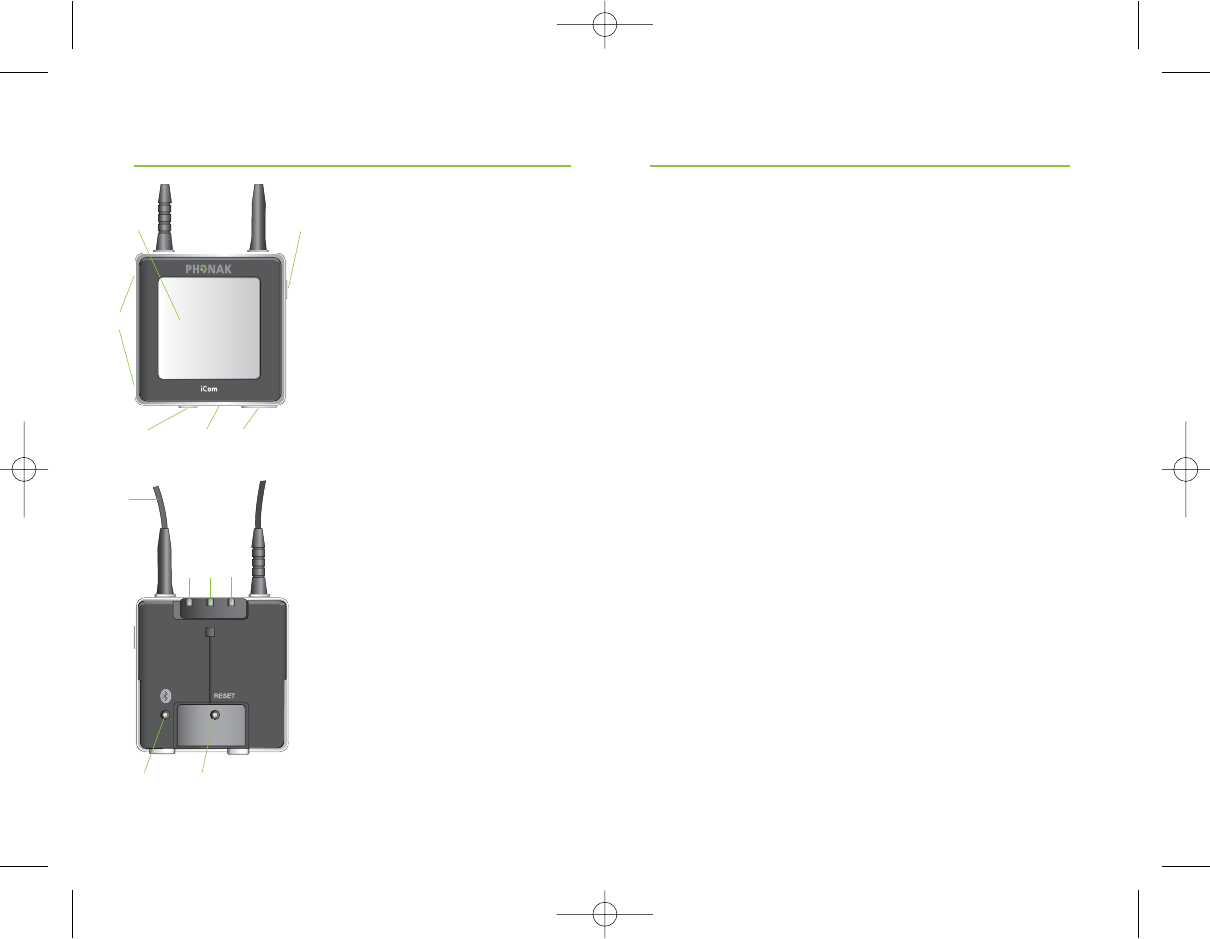
8
Description
ቢ
ቤብ
ቮ
ቩ
ቫቪቭ
ባ
ቦቨ
ቧ
9
• Audio cable, 1m (3 ft.)
• USB cable, 3m (10 ft.)
• Power supply Bluetooth audio adapter
Contents may vary depending on country.
iCom accessories
Buttons
ቢON/OFF button
ባCommunication button
ቤBluetooth pairing button
ብReset button
Inputs
ቦAudio input (3.5mm jack)
ቧFM input (Europlug)
ቨCharging input (mini-USB)
ቩMicrophone openings
Indicators
ቪBattery indicator
ቫAudio streaming indicator
ቭBluetooth indicator
Other
ቮNeckloop
GA_iCom_GB.qxp 4.1.2008 14:12 Uhr Seite 8
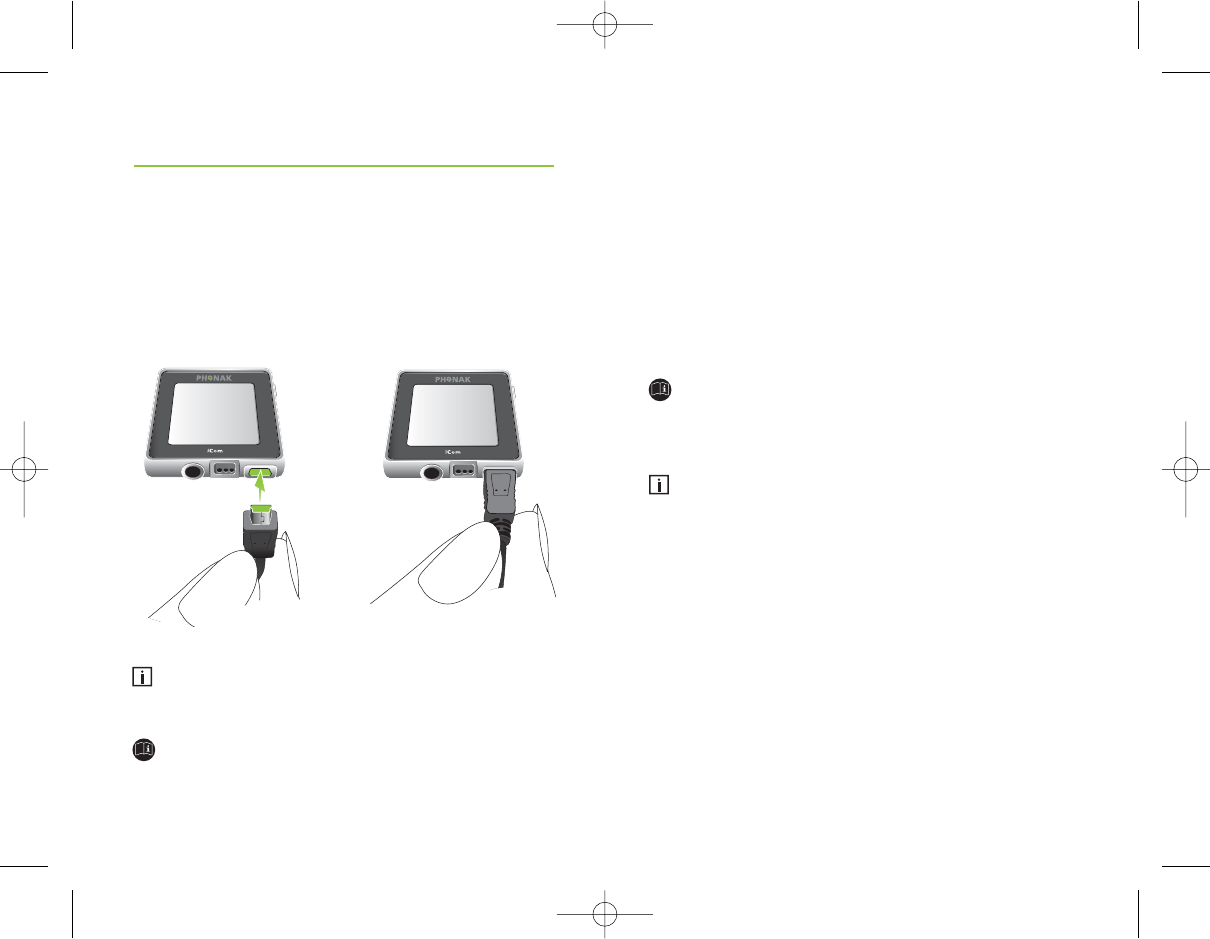
10
Charging the battery
Your iCom has an internal, rechargeable battery.
To charge it, plug in the charging cable as shown in
the picture below. Then plug the other end of the
charging cable into a power outlet.
Your iCom will turn OFF automatically when a
charger is connected.
For safety reasons, recharge the battery only with
chargers supplied by Phonak.
Getting Started
11
During the charging process, the battery indicator
will light orange. Once the battery is fully charged, the
indicator will turn green.
Charging an empty battery typically takes about
90 minutes. It is safe to leave the charger connected
overnight—the battery cannot be overcharged.
When charging your iCom for the first time, leave
it to charge for at least three hours, even if the
battery indicator turns green earlier.
A new battery’s full performance is achieved only
after two or three complete charge and discharge
cycles.
Operating time
Fully charged, your iCom will operate for up to
10 hours in normal use.
Battery consumption and the operating time of the
iCom depends greatly on the usage of the device. Heavy
use of the audio streaming and Bluetooth functions
will reduce the operating time of your iCom between
battery recharges.
GA_iCom_GB.qxp 4.1.2008 14:12 Uhr Seite 10
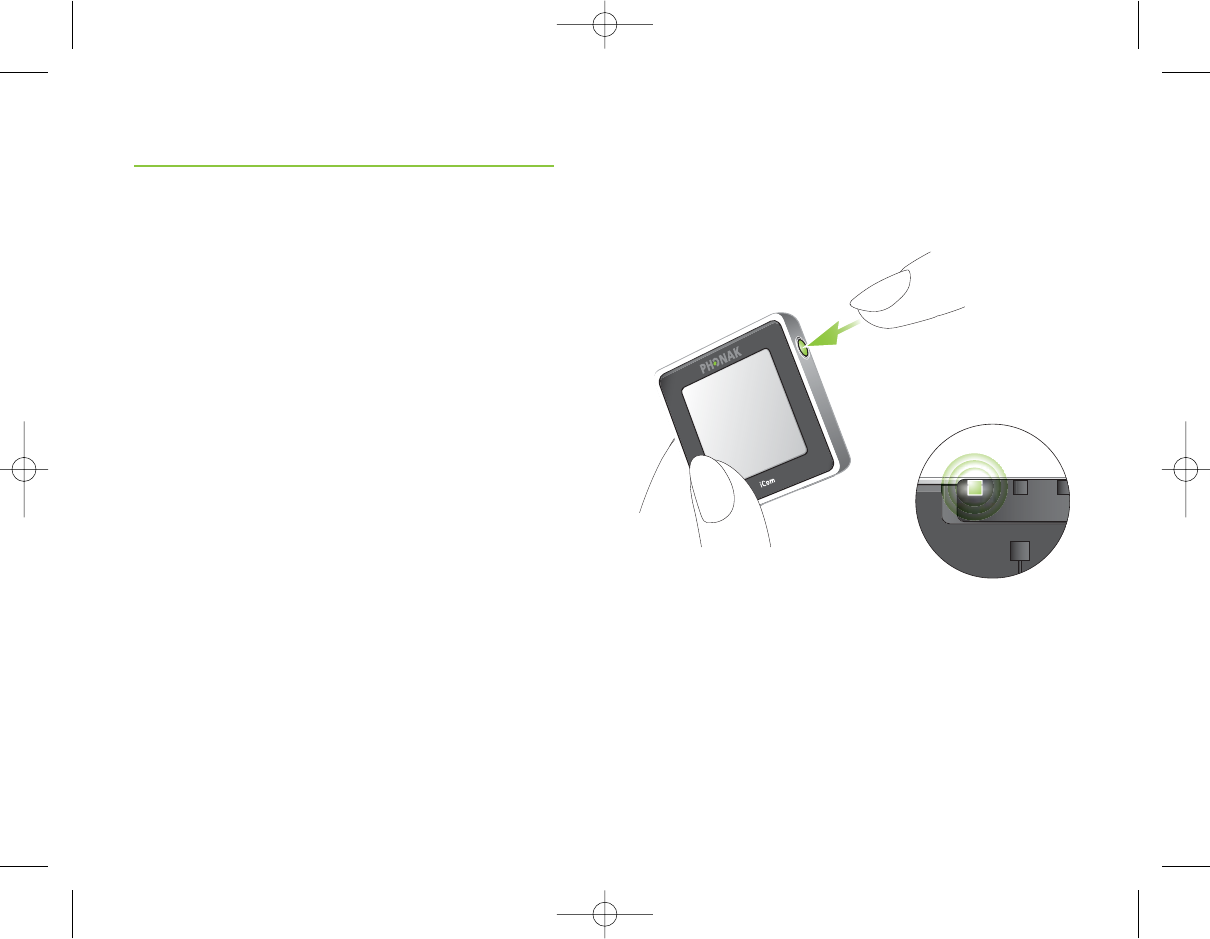
12
Getting Started
Your iCom battery can be charged hundreds of
times. If the operating time of your iCom reduces
substantially, please contact your hearing care
professional.
Battery status
While turned ON, your iCom indicates the battery
status on the battery indicator as follows:
• Green, slow flash ୴Battery level is high
• Orange, medium flash ୴Battery level is moderate
• Red, fast flash ୴Battery level is low
Once the fast, red flashing starts, your iCom will still
operate for about an hour, but you should recharge the
battery as soon as possible.
Turning your iCom ON or OFF
To turn ON your iCom, press and hold the ON/OFF
button as shown in figure ቢ for about a second until
you see the battery indicator turn on as shown in
figure ባ. Release the ON/OFF button. Once your iCom
is fully operational, the battery indicator will be
13
colored and flash according to the current battery
charge as described above.
To turn OFF your iCom, press and hold the ON/OFF
button for about two seconds until you see the battery
indicator turn green. Once you release the ON/OFF
button, the battery indicator will go dark and your iCom
will be OFF.
ቢ
ባ
GA_iCom_GB.qxp 4.1.2008 14:12 Uhr Seite 12
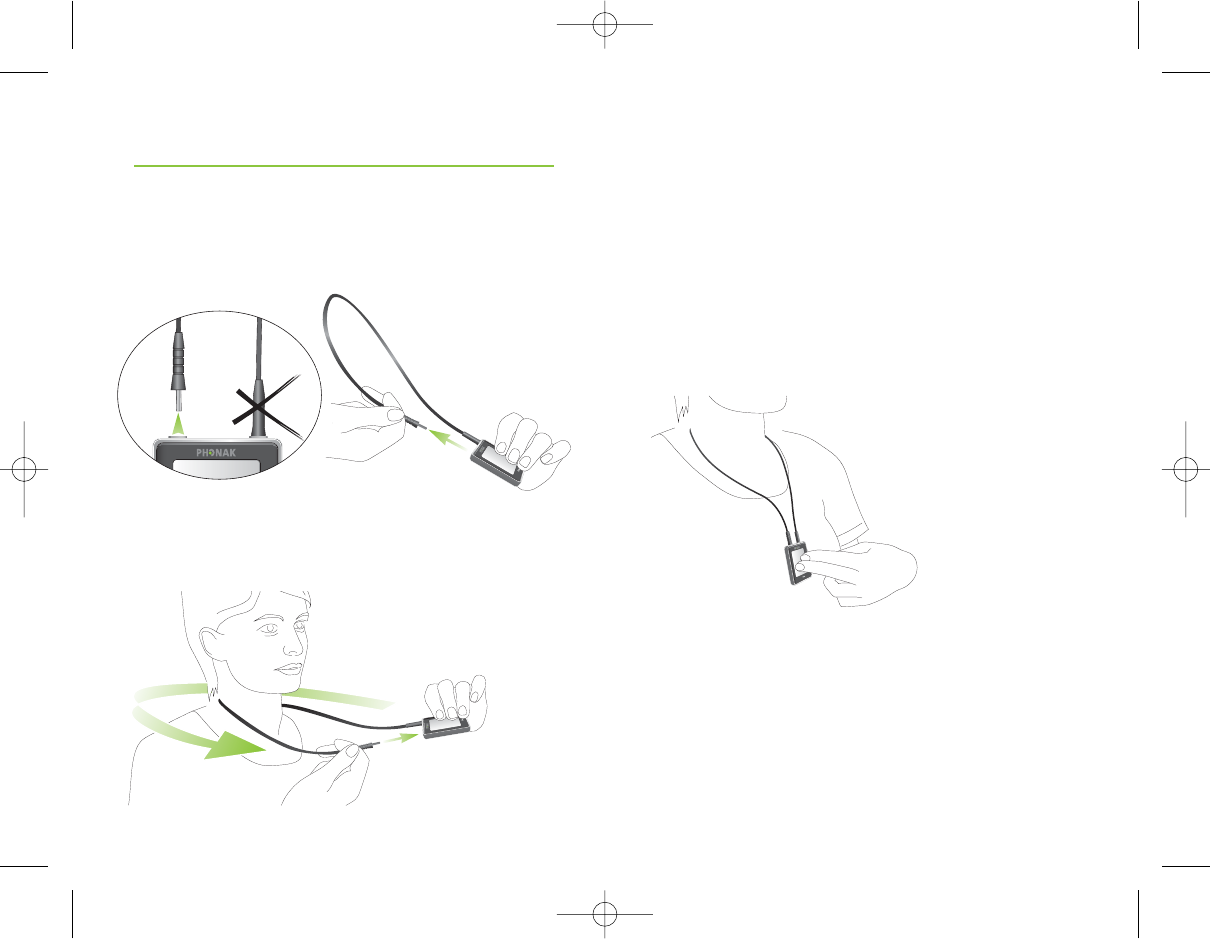
15
14
Wearing your iCom
To put your iCom around your neck, open the neckloop
by unplugging it as shown in the picture below.
Plug in the neckloop as shown below. This will activate
the built-in antenna and is necessary for the iCom to
communicate with your hearing instruments.
Checking the connection to your
hearing instruments
To check that your iCom and at least one hearing
instrument can communicate successfully, briefly press
the communication button. If the check was successful,
the streaming indicator will light yellow for a few
seconds.
If the connection check fails, the streaming indicator
will rapidly flash yellow for a few seconds. In this
case, refer to the troubleshooting section of this guide
on page 58.
Getting Started
GA_iCom_GB.qxp 4.1.2008 14:12 Uhr Seite 14
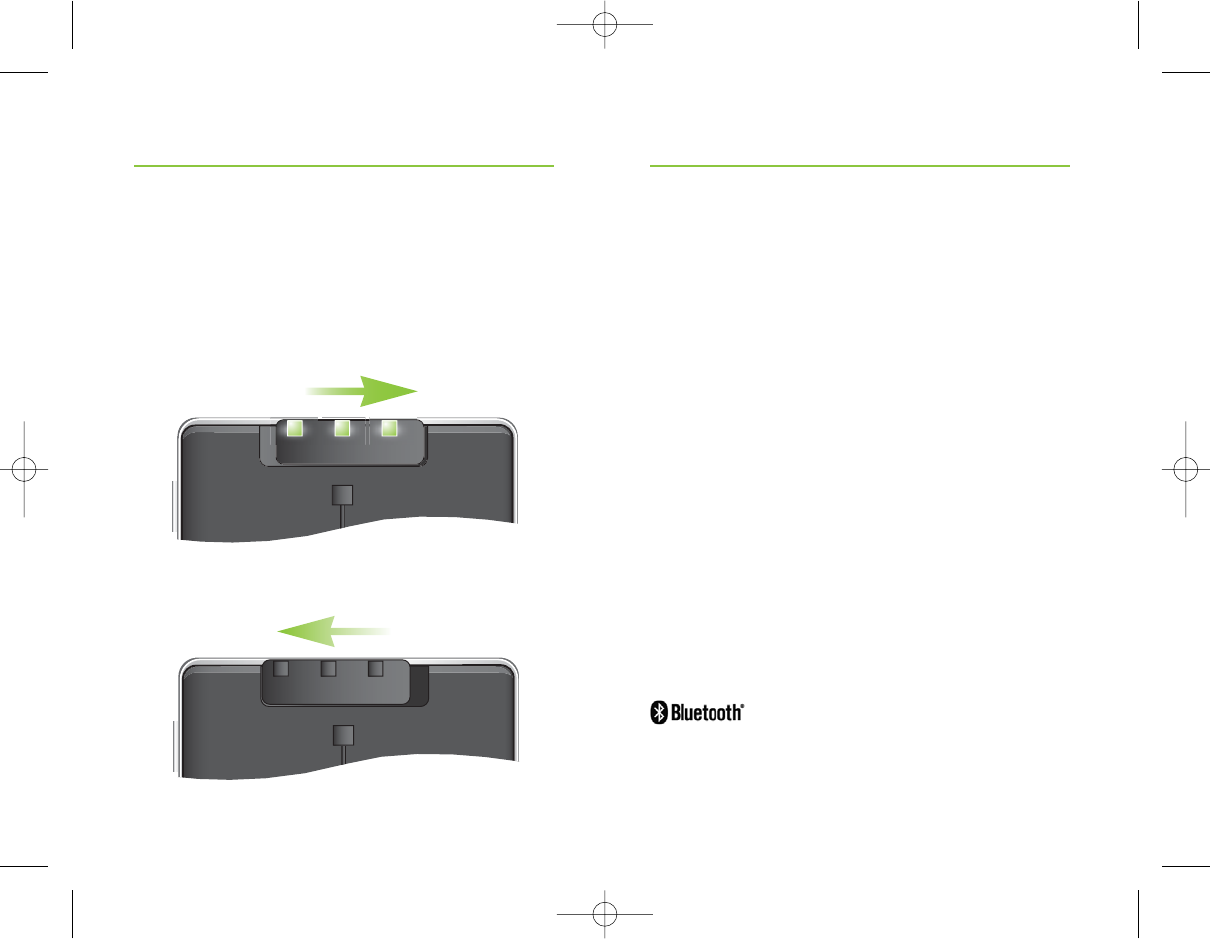
17
16
Indicators cover
If you prefer to hide the indicators, engage the
indicator cover as shown below.
Indicators visible
Indicators covered
Getting Started Introduction to Bluetooth
What is Bluetooth?
Bluetooth provides a way for devices like mobile
telephones, laptops and personal computers to
communicate wirelessly.
Your iCom supports Bluetooth to allow audio to be
wirelessly received from many different audio devices
and transmitted to your hearing instruments. For
example, you can receive mobile phone calls directly
to your hearing instruments or listen to music from
your PC.
For further information about Bluetooth, visit
www.bluetooth.org.
What Bluetooth devices can I use with my iCom?
First, check whether the device you wish to use is
Bluetooth-enabled: Look for the following symbol on
the device or in its user guide.
Second, the range of possible applications on a Blue-
tooth-enabled device is defined by “profiles”. The device
GA_iCom_GB.qxp 4.1.2008 14:12 Uhr Seite 16

19
18
you wish to use with your iCom must support the
appropriate Bluetooth profiles. These differ depending
on what you want to do with your iCom:
• To receive mobile phone calls your mobile phone
must support either the “Handsfree” or “Headset”
profile. Many, but not all mobile phones support
these Bluetooth profiles. Look for this information
in your mobile phone’s user guide.
• To listen to stereo music from your mobile phone or
PC, it must support the “A2DP” / “Stereo Headset”
profile. Fewer devices support this Bluetooth profile.
Look for this information in your device’s user
guide.
Bluetooth device compatibility
Although Bluetooth is a widely-supported standard,
manufacturers differ in how they implement it.
Unfortunately, some Bluetooth-enabled devices are
compatible only with certain other devices. If a
problem occurs in the connection between your device
and your iCom, or if you are uncertain regarding
your device’s Bluetooth capabilities, please consult your
device’s user guide or ask the manufacturer.
Bluetooth operating range
Your iCom supports Bluetooth operation up to a range
of 10m (30 ft.). Line-of-sight between your iCom and
other device is not required. However, the following
factors may affect the range achieved:
• Interference in the environment may reduce
the operating range of Bluetooth.
• The Bluetooth device with which you are
connecting may support a more limited range
than the 10m supported by the iCom.
If your Bluetooth device moves out of range of your
iCom and has an active audio connection, this
connection will be terminated. If the device is then
moved back into range of your iCom, it may or
may not resume streaming to your hearing instruments.
This depends on the device.
Introduction to Bluetooth
GA_iCom_GB.qxp 4.1.2008 14:12 Uhr Seite 18

21
20
Using a Bluetooth device: pairing and connecting
If your device is Bluetooth-enabled and supports the
appropriate profiles, it can communicate with the
iCom only after completing two simple procedures:
Pairing and connecting.
The pairing procedure allows you to control which
Bluetooth devices are permitted to communicate with
each other. It needs to be completed only once for
each device you wish to use with your iCom. The pairing
procedure is described in detail for each of the
Bluetooth device types in the sections which follow.
Once a device is permitted to communicate with the
iCom by the pairing procedure, the connection
procedure configures the device to actually output
its audio signal over the Bluetooth connection. This
procedure is also described in the sections which follow.
Some Bluetooth devices perform the connection
procedure automatically after pairing.
Introduction to Bluetooth Setting up Bluetooth devices
This section describes the pairing and connection
procedure for Bluetooth devices.
Pairing with your mobile phone
As described above, it is only necessary to perform
the pairing procedure once. The pairing procedure
is controlled by your mobile phone. Different mobile
phones have different menu structures. You should
therefore refer to your mobile phone’s user guide or
dealer support if you cannot complete the pairing
procedure with the generic steps described here. On
the Internet, at www. phonak.com/icom, Phonak
also provides Bluetooth pairing instructions specific to
some of the most popular mobile phone manufacturers.
To pair your iCom and mobile phone:
1. Charge and turn ON both your iCom and mobile
phone. Place them next to each other.
2. Find the connectivity settings of your phone. Look
for the “Bluetooth” feature in the main menu or
one of the submenus such as “Connectivity”.
3. On your mobile phone, ensure that the Bluetooth
feature is turned ON.
4. Initiate the pairing process on your iCom by
pressing the Bluetooth button for about 2 seconds
GA_iCom_GB.qxp 4.1.2008 14:12 Uhr Seite 20
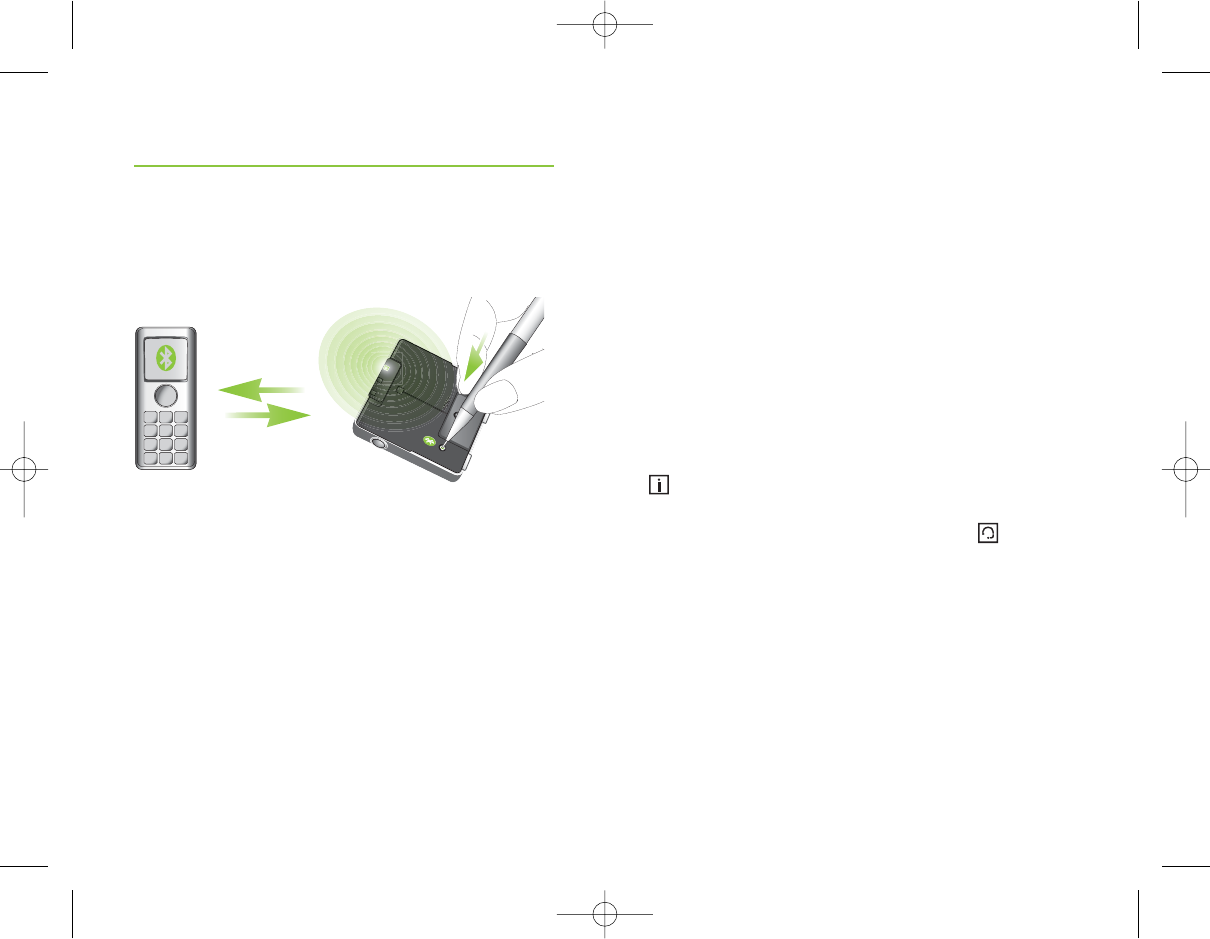
23
22
until the Bluetooth indicator flashes blue. Your
iCom will remain in the pairing mode for two minutes
or until the pairing is completed.
5. On your mobile phone choose to search for
Bluetooth devices.
6. Your mobile phone should present a list of Bluetooth
devices discovered. Select “iCom” from this list.
7. Your mobile phone may then ask you to enter a
passcode. If so, enter “0000” (four zeros).
Your iCom should now be paired to your mobile phone.
Some mobile phones may ask which Bluetooth service
you wish to enable. Select “Headset” and, if available,
“Stereo Headset”.
Setting up Bluetooth devices
Connecting your mobile phone
Once your mobile phone and iCom are paired, the
mobile phone needs to be ‘connected’ to your iCom
before it will actually send audio signals to it. This
function should also appear in your mobile phone’s
“Bluetooth” menu, usually under a list of “Paired
devices”. In that list, highlight your iCom and select
“Connect”. Confirmation of successful connection
is indicated on iCom by the Bluetooth indicator slowly
flashing blue.
When your iCom and mobile phone are connected,
you may see a headset symbol on the main screen
of your mobile phone, similar to this:
The connection between your iCom and your mobile
phone will be maintained as long as the two devices
remain ON and within range of each other. If either
device is switched off or moves out of range, you may
need to perform the connection procedure again.
On some phones you can configure “Automatic
reconnection”. We recommend that you do so if this
feature is available. Refer to the user guide of
your mobile phone for instructions on how to do this
if supported.
GA_iCom_GB.qxp 4.1.2008 14:12 Uhr Seite 22
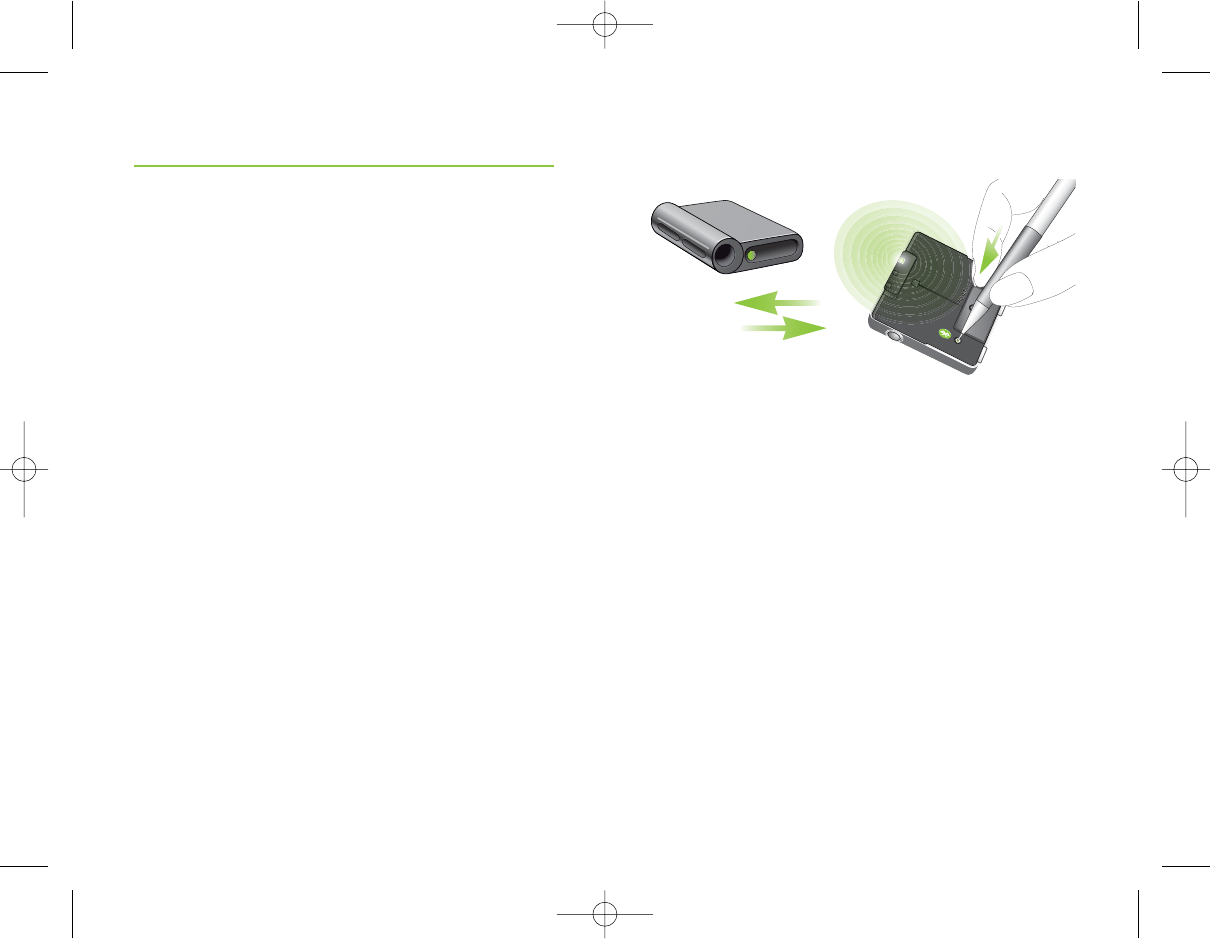
25
24
Pairing and connecting iCom with a
Bluetooth transmitter
If you wish to use your iCom to listen to music from
your stereo system or make phone calls with your
landline telephone but these devices are not equipped
with Bluetooth functionality, you may use an external
Bluetooth transmitter.
As described above, it is necessary first to perform the
Bluetooth pairing procedure between your iCom and
Bluetooth transmitter. The pairing procedure is controlled
by the device with which you are attempting to pair.
Such devices vary in the procedure they require for pairing.
You should therefore refer to your device’s user guide
or dealer support if you cannot complete the pairing
procedure with the generic steps described here.
1. Charge and turn ON both your iCom and Bluetooth
transmitter. Place them next to each other.
2. Initiate the pairing process on your iCom by pressing
the Bluetooth button for about 2 seconds until
the Bluetooth indicator flashes blue. Your iCom will
remain in the pairing mode for two minutes or
until the pairing is completed.
3. Set your Bluetooth transmitter into pairing
mode. With some devices, simply turning them
ON initiates the pairing process.
4. A Bluetooth transmitter typically doesn’t require
a passcode or passkey to establish a connection
with iCom. After initiating pairing, simply wait until
the devices have completed the pairing process.
If a passcode is required, enter “0000” (four zeros).
Typically, with Bluetooth transmitters the connec-
ting process is automatically performed after pai-
ring.
Confirmation of successful connection is indicated
on iCom by the Bluetooth indicator slowly flashing blue.
If this is not the case, refer to the user guide of your
Bluetooth transmitter.
Setting up Bluetooth devices
GA_iCom_GB.qxp 4.1.2008 14:12 Uhr Seite 24

27
26
Pairing and connecting iCom with a
Personal Computer (PC)
If you wish to use your iCom to listen to audio on
PC, you can do so if your PC supports Bluetooth.
As described above, it is necessary first to perform the
Bluetooth pairing procedure between your iCom and
PC. You should therefore refer to your PC’s user guide
or dealer support if you cannot complete the pairing
procedure with the generic steps described here.
1. Charge and turn ON your iCom. Turn on your PC.
Place your iCom near your PC.
2. On the PC, open the “Control Panel” and select the
Bluetooth device wizard. This will assist you in
setting up a Bluetooth connection between your
iCom and PC.
3. Ensure the Bluetooth connectivity is turned ON:
Either activate built-in Bluetooth functionality or
connect the external Bluetooth adapter on your PC.
4. Initiate the pairing process on your iCom by pressing
the Bluetooth button for about 2 seconds until
the Bluetooth indicator flashes blue. Your iCom will
remain in the pairing mode for two minutes or
until the pairing is completed.
5. On the PC, choose to find and add a specific
Bluetooth device.
6. Of the devices found, choose iCom.
7. When the PC prompts for a passcode or PIN,
enter “0000” (four zeros).
8. Allow devices to complete the establishment of
a trusted link.
9. If prompted on the PC to choose Bluetooth services,
you may have several options available. Select
the "Stereo Headset" functionality to stream audio
in stereo. After choosing which services you wish
to enable, you can finish the connection and exit
the setup on the PC.
Confirmation of successful connection is indicated on
iCom by the Bluetooth indicator slowly flashing blue.
Setting up Bluetooth devices
GA_iCom_GB.qxp 4.1.2008 14:12 Uhr Seite 26
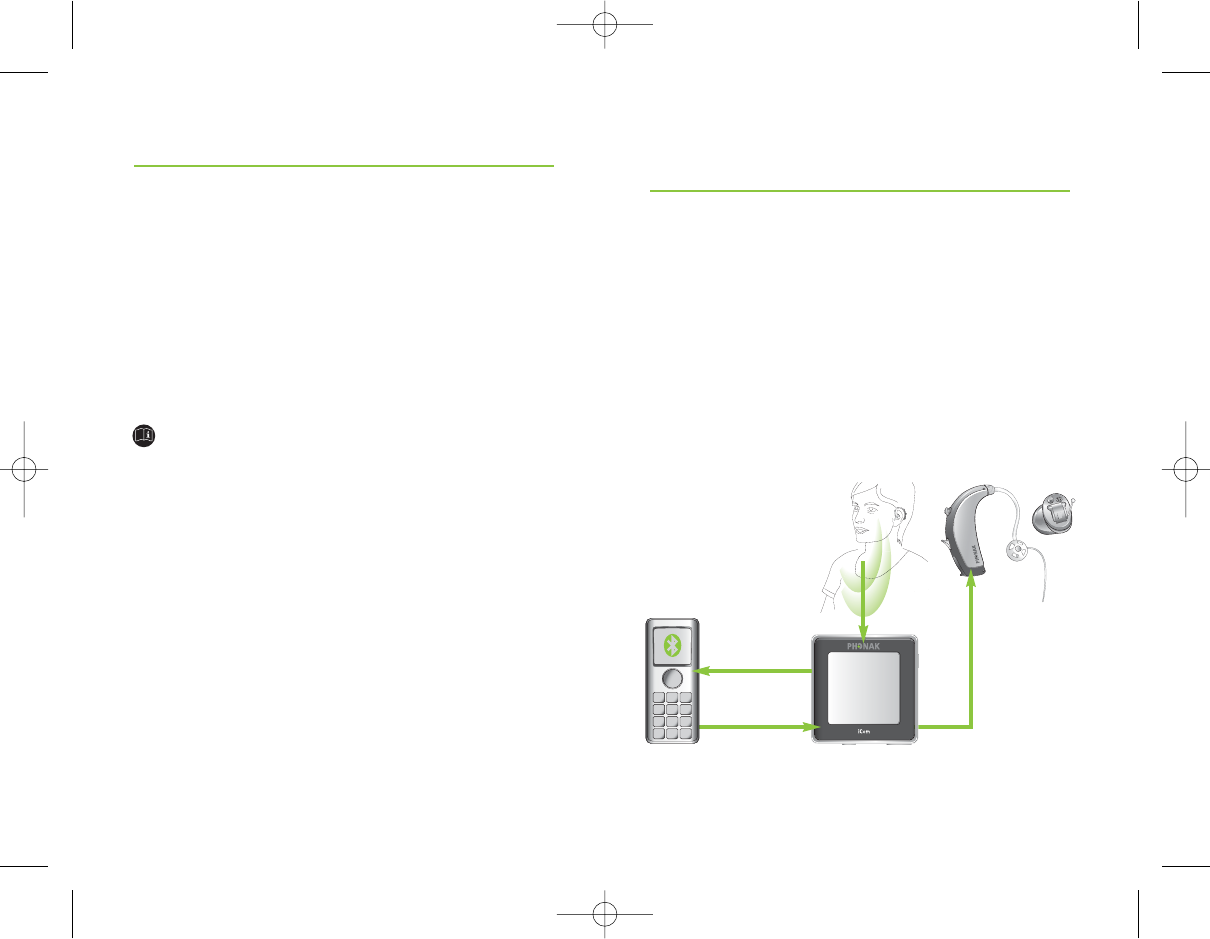
28 29
For further information please refer to the user guide
provided with the PC or external Bluetooth adapter.
Deleting Bluetooth pairings
If you wish to delete the pairing relationships between
your iCom and other devices, press and hold the
Bluetooth pairing button for about 10 seconds until the
Bluetooth indicator is lit solid blue.
After deleting the Bluetooth pairings, none of
your Bluetooth devices will work with your iCom
until paired again.
Setting up Bluetooth devices Using your iCom with your
mobile phone
Before you can use your iCom with your mobile phone,
you must complete the pairing and connection
procedures described in the “Setting up Bluetooth
devices” section above.
How your iCom interacts with your mobile phone
When making a mobile-phone call, the iCom’s built-in
microphone captures your voice and transmits it to the
mobile phone. This frees you from holding the phone
to your head to speak.
Bluetooth Wireless signal
Your voice Caller’s voice
audible here
Caller’s voice
GA_iCom_GB.qxp 4.1.2008 14:12 Uhr Seite 28

31
30
The other party’s voice is received by your mobile
phone, which transmits it to your iCom. Your iCom
transmits it to your hearing instruments.
Your iCom’s communication button is used to accept,
reject and end phone calls as described in the sections
below.
Some mobile phones support additional features
such as voice dialing. Please refer to your mobile
phone user guide for information about these
features.
Some mobile phones are configured to play
keypress tones and confirmation beeps via Blue-
tooth headsets. If this is set, you will hear these
tones interrupting any active audio streaming
in your hearing instruments. Please refer to your
mobile phone user guide for information about
disabling this feature.
Mobile phone calls will always take priority
over other audio sources on your iCom. For more
information refer to the section “Streaming
priorities” on page 37.
Speaking into your iCom
Your iCom includes a high-quality directional
microphone. It is placed on the side to optimally pick
up your voice without extraneous noise when you
wear your iCom around your neck.
When engaged in a mobile phone call, speak normally
as shown in figure ቢbelow. In noisy environments,
you can bring your iCom closer to your mouth as shown
in figure ባ. In this case, avoid covering the small
microphone openings on the side of your iCom (figure
ቤ). Turning your iCom sideways is unnecessary and
will not increase the sound quality (figure ብ).
Using your iCom with your mobile phone
ቢባ ቤ
ብ
GA_iCom_GB.qxp 4.1.2008 14:12 Uhr Seite 30
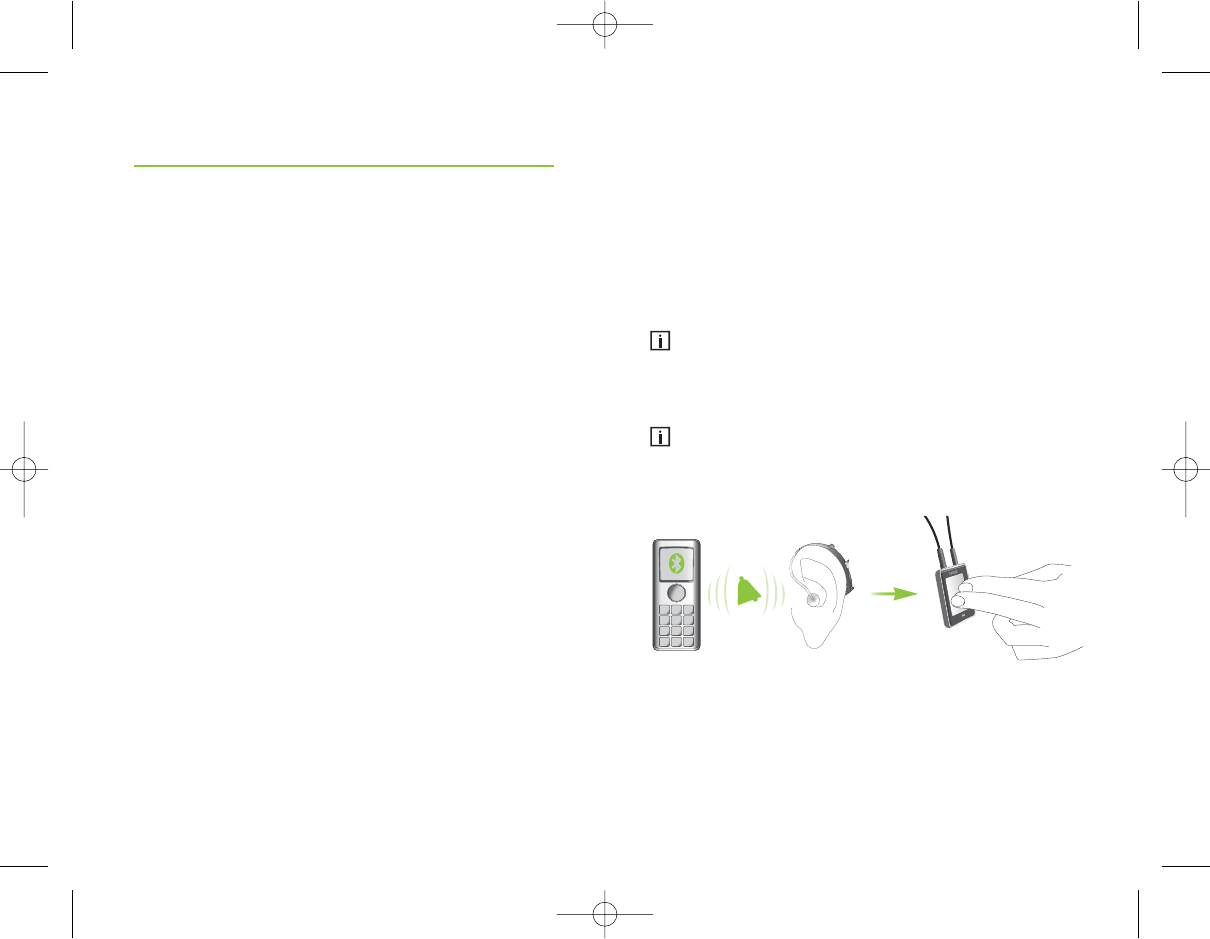
33
32
Moving out of Bluetooth range
If your mobile phone leaves the Bluetooth range of
your iCom, the connection will be lost. If this happens
during a phone call, the mobile phone will terminate
the call, even in cases where the “Automatic reconnection”
feature has been enabled on the mobile phone.
Incoming calls
When a call is received on your mobile phone, the
Bluetooth indicator will flash and you will hear the
ringing tone in your hearing instruments.
Your iCom can receive incoming calls while streaming
audio from other sources, such as listening to music via
audio jack. After rejecting or completing the call, your
iCom will resume streaming the music from the audio
jack.
Accepting incoming calls
To accept an incoming call, briefly press the
communication button on your iCom. You will hear
the caller’s voice in both hearing instruments.
It will take about 1 second before the link from
the mobile phone to the hearing instruments is
established.
For your safety, the hearing instruments’
microphones will remain ON at reduced level
during phone calls.
Using your iCom with your mobile phone
GA_iCom_GB.qxp 4.1.2008 14:12 Uhr Seite 32
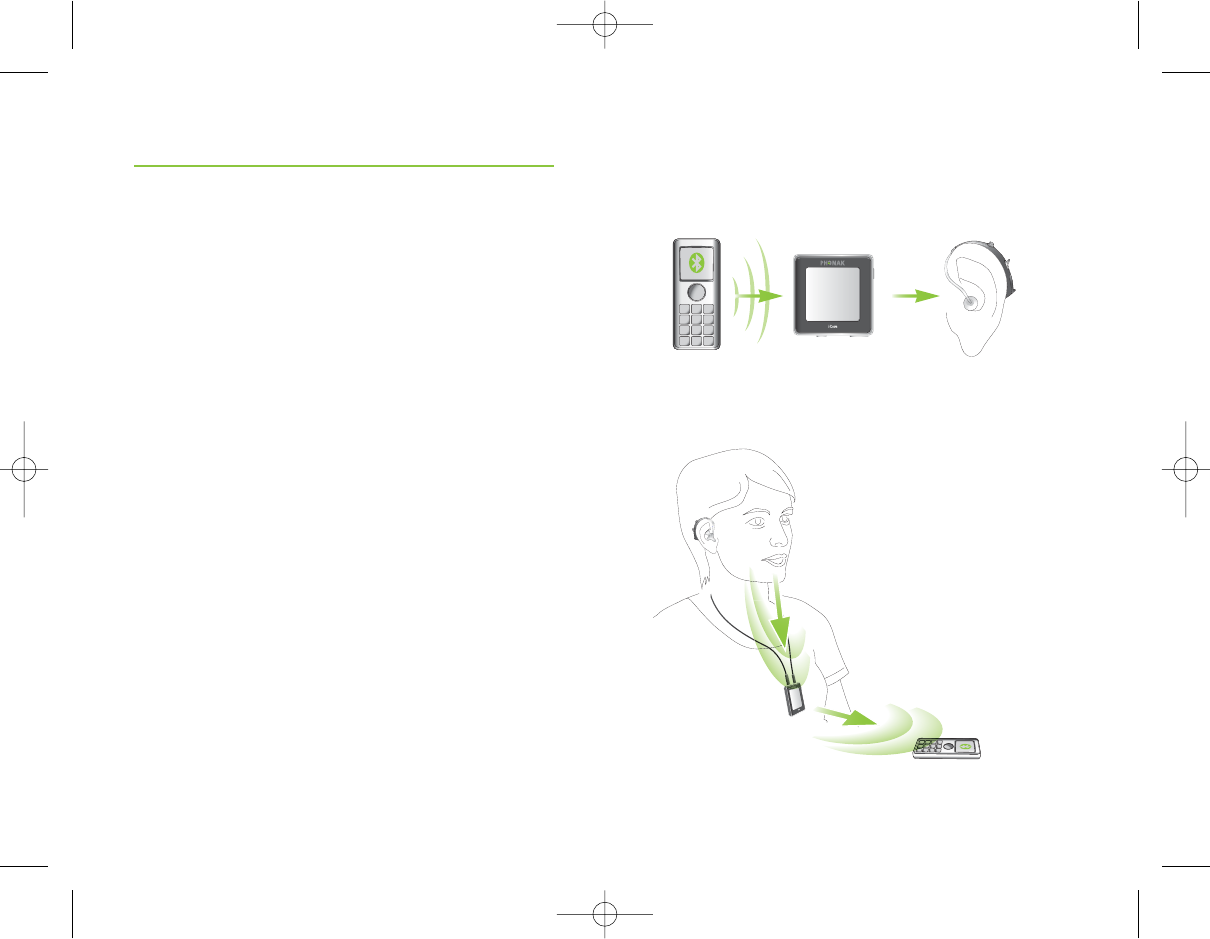
35
34
Rejecting incoming calls
If you prefer not to answer a call, press and hold the
communication button on your iCom for about two
seconds until you hear the call-rejection beep in your
hearing instruments and the Bluetooth indicator
turns OFF. Your iCom will command your mobile phone
to reject the call and send a busy signal.
Rejecting the call by operating your mobile phone
directly will have the same effect.
Making a call
Initiating a phone call is not any different with or
without iCom: Simply use the mobile phone keyboard
to enter or select a number and dial.
If connected, you will hear the ringing indication in
your hearing instruments and they will activate the
dedicated Bluetooth phone program.
Using your iCom with your mobile phone
Once the connection is established,
no further manipulation of the
phone is required.
Speak into iCom –
not into the mobile phone –
when the called party
answers.
GA_iCom_GB.qxp 4.1.2008 14:12 Uhr Seite 34
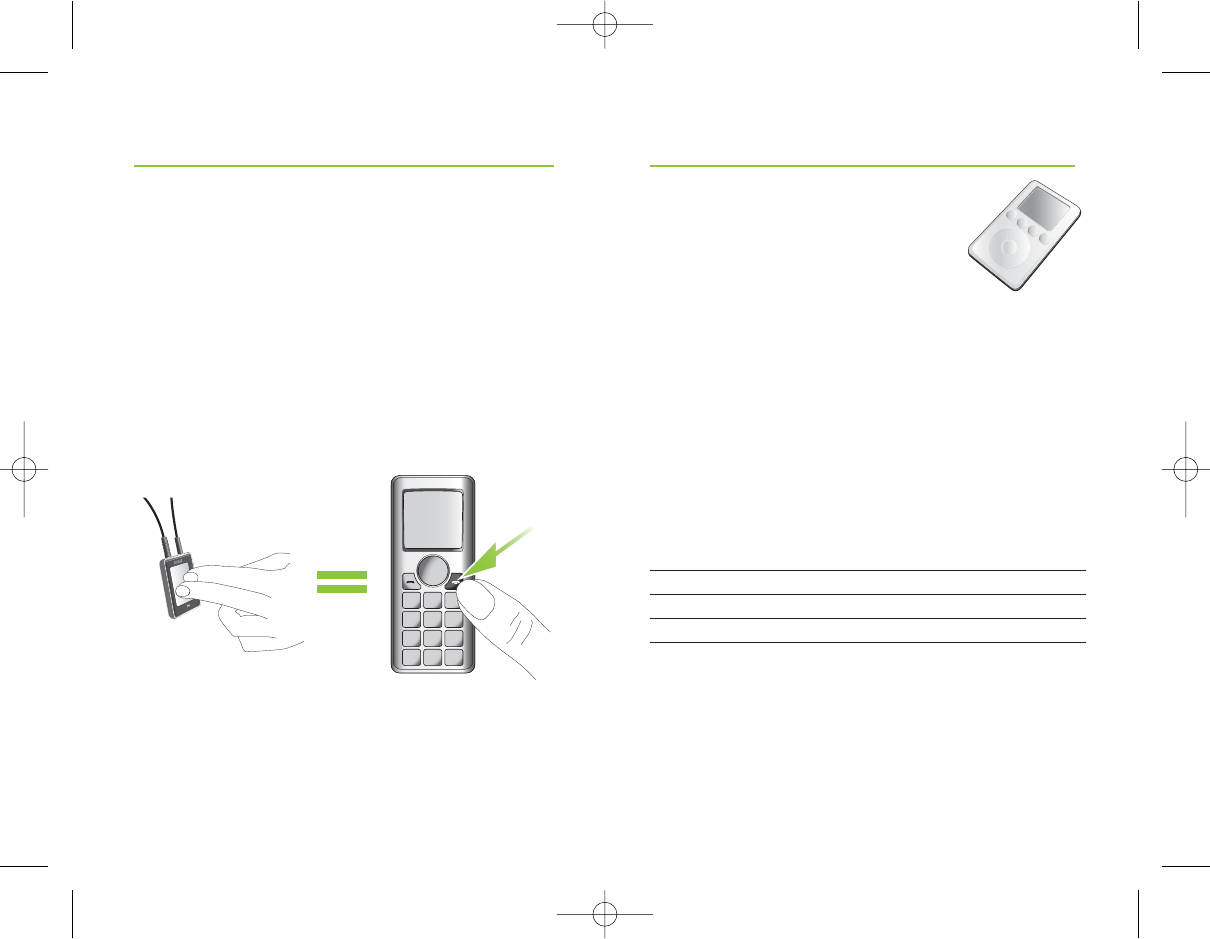
37
36
Ending a call
To end a phone call via your iCom, briefly press the
communication button. The call will terminate and
your hearing instruments will return to the default
program or previously-active audio source (such as
the jack input).
Ending a call by operating your mobile phone instead
of your iCom will have the same effect.
Using your iCom with your mobile phone
Audio streaming enables you
to hear audio from an MP3 player
or other audio source directly in
your hearing instruments, which then
function like a wireless, stereo headset.
Streaming priorities
An audio source can be connected to your hearing
instruments through the iCom in three ways: via audio
cable, via a Bluetooth connection or via FM receiver.
The following summarizes the priority given to
different audio sources:
1Bluetooth phone call
2Audio jack
3FM receiver
4Bluetooth stereo headset
First priority is always given to mobile phone calls:
You will hear the ringing indication even when
listening to other audio sources via cable, Bluetooth or
FM. If you push the communication button to accept
the call, streaming is switched to the phone call. If you
Using audio devices & FM
GA_iCom_GB.qxp 4.1.2008 14:12 Uhr Seite 36
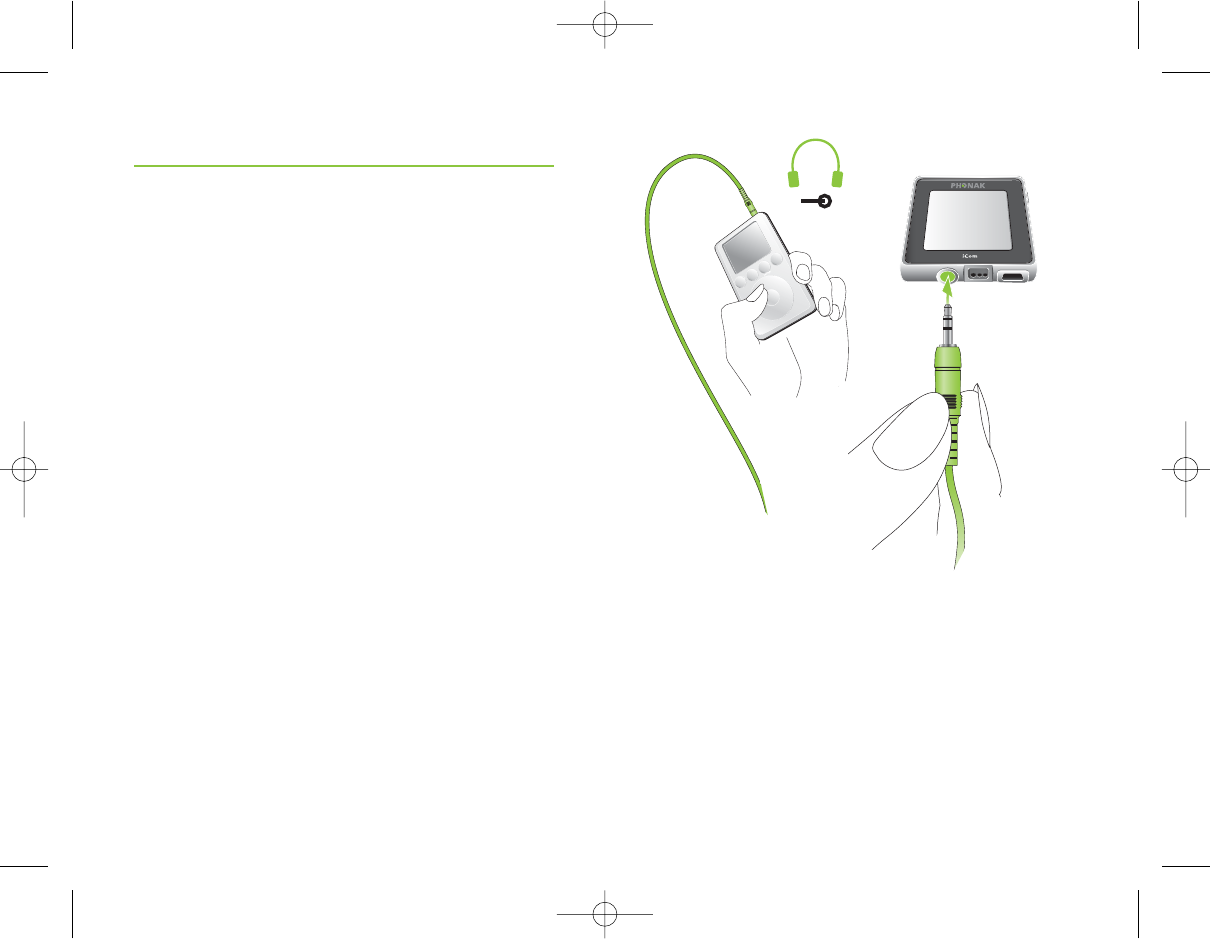
38 39
reject, or terminate the call, audio streaming will
resume. If more than one Bluetooth audio source is in
range e.g. two Bluetooth stereo devices, iCom will
connect to only the last connected device.
It is not possible to switch between two Bluetooth
audio sources. (One Bluetooth device must be turned
OFF or moved out of range from iCom before the
second device is turned ON or moved inside the range
of iCom).
Audio streaming can be activated in the hearing
instruments independent of which hearing program
you have selected on your hearing instruments.
Connecting via audio cable (3.5 mm jack)
Connect the audio player to iCom with an audio
cable as shown in the following picture.
ቢInsert one end of the audio cable into the
headphones socket on your audio player.
ባInsert the other end of the audio cable into
the audio input on your iCom.
Connecting via Bluetooth
If your audio source is equipped with Bluetooth
functionality or if you use an external Bluetooth
adapter, you can stream audio wirelessly via
Bluetooth. In order to use your iCom with a Bluetooth
enabled audio device or transmitter, you must first
pair the devices. Please refer to the section “Pairing
iCom with a Bluetooth transmitter” for further details.
Using audio devices
AUDIO
3.5 mm jack
ቢ
ባ
GA_iCom_GB.qxp 4.1.2008 14:12 Uhr Seite 38
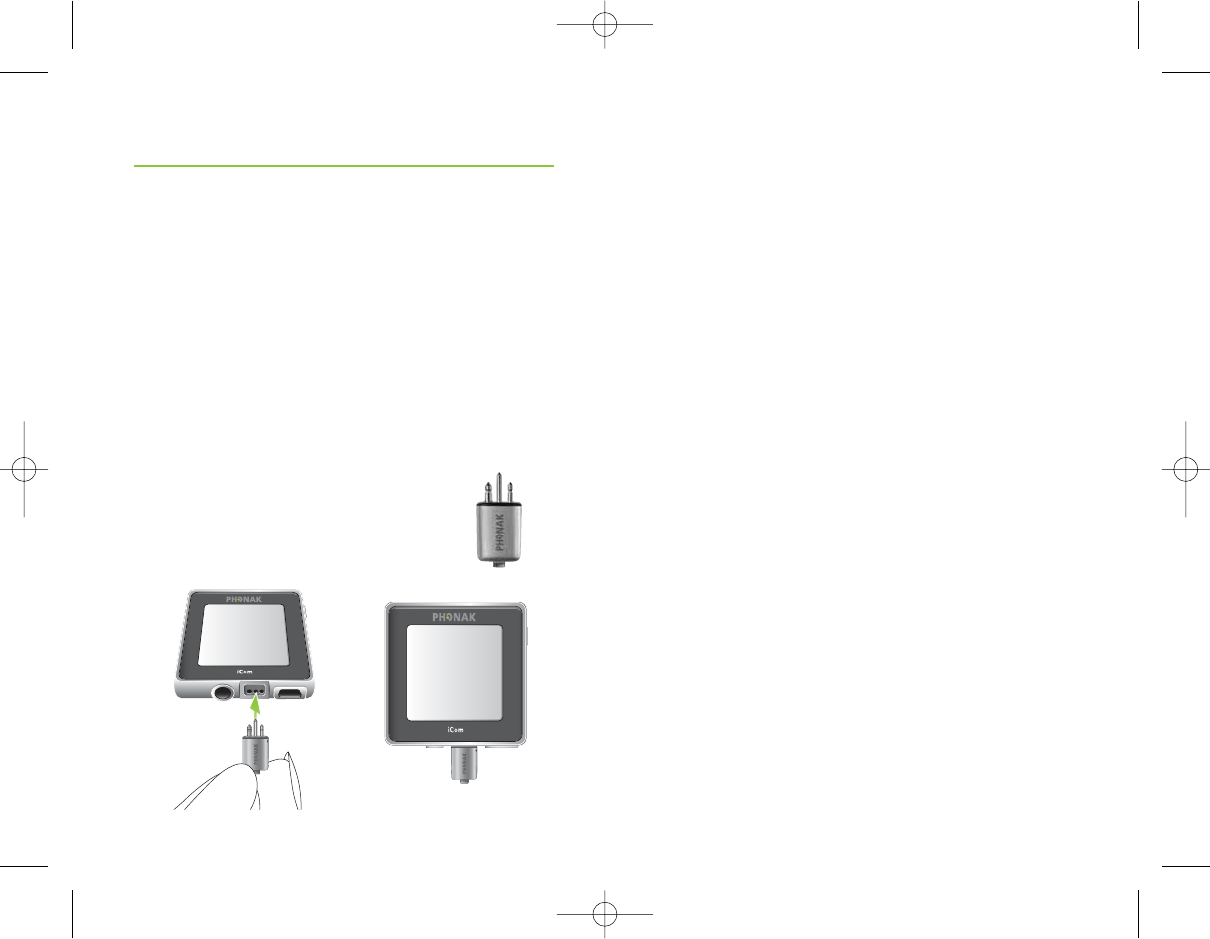
41
40
• Place the FM transmitter near the sound source or
connect it to your TV, radio etc. and turn it ON.
• Turn the FM receiver ON. If you use a MicroMLxS,
receiver, set the switch to the position "•".
The FM transmitter transmits the signal via radio to
your FM receiver attached to iCom. The FM signal
is then sent to your hearing instruments via iCom.
The streaming indicator will light solid yellow to
indicate FM usage.
The FM connection will remain ON for at least
60 seconds even with no signal transmitted to ensure
uninterrupted transmission in situations such as
lectures.
To deactivate FM, turn OFF the attached FM receiver or
unplug it. iCom will automatically activate the default
hearing program.
For more information about the usage of your FM
system, please refer to the respective user guide.
Using audio devices
Connecting via FM system
When noise, distance or reverberation is a problem, FM
systems greatly improve communication. A wireless
FM communication system consists of a transmitter and
a receiver. The transmitter is placed near, or directly
connected to the sound source (e.g. TV or radio).
It transmits the signal via radio to your FM receiver
(MLxi or MicroMLxS) attached to your iCom. The
FM signal is then sent to your hearing instruments via
the iCom.
• Attach your FM receiver to iCom
via the FM input (Europlug)
as shown in the picture below.
GA_iCom_GB.qxp 4.1.2008 14:12 Uhr Seite 40

42 43
Start streaming
Set the volume of your audio source to a medium level
and press play on your audio source to start. iCom
will automatically detect the audio signal and you will
hear the sound in your hearing instruments. Your
hearing instruments will automatically switch to a
special program which provides you with optimal
sound quality.
If connected via audio cable or FM receiver, the
streaming indicator will light solid yellow. If connected
via Bluetooth, the Bluetooth indicator will light solid
blue.
Pause streaming
To temporarily interrupt the streaming, e.g. if someone
wants to speak to you, press the communication button
on iCom. The hearing instruments will switch to normal
operation.
If connected via audio cable or FM receiver, the
streaming indicator flashes yellow while in pause. If
connected via Bluetooth, the Bluetooth indicator
flashes blue when paused.
To resume streaming, press the communication button
on iCom again.
In most cases, the streaming pause operation will
not pause your audio device. An MP3 player,
connected via audio jack, will continue playing
music, although you will not hear it in your hearing
instruments. Some Bluetooth devices provide
support to respond to a pause command from the
iCom. In these cases the audio will be paused
on your device, and may be resumed from the same
position later.
Stop streaming
To stop streaming audio, turn OFF the audio source,
unplug the audio cable or disengage the audio devices’
Bluetooth functionality.
When streaming stops, iCom will automatically
activate the default hearing program. This occurs
whenever the streaming signal stops for more
than 5 seconds. (Except in the case of FM, which will
stop after 60 seconds to accommodate lectures).
Using audio devices
GA_iCom_GB.qxp 4.1.2008 14:12 Uhr Seite 42
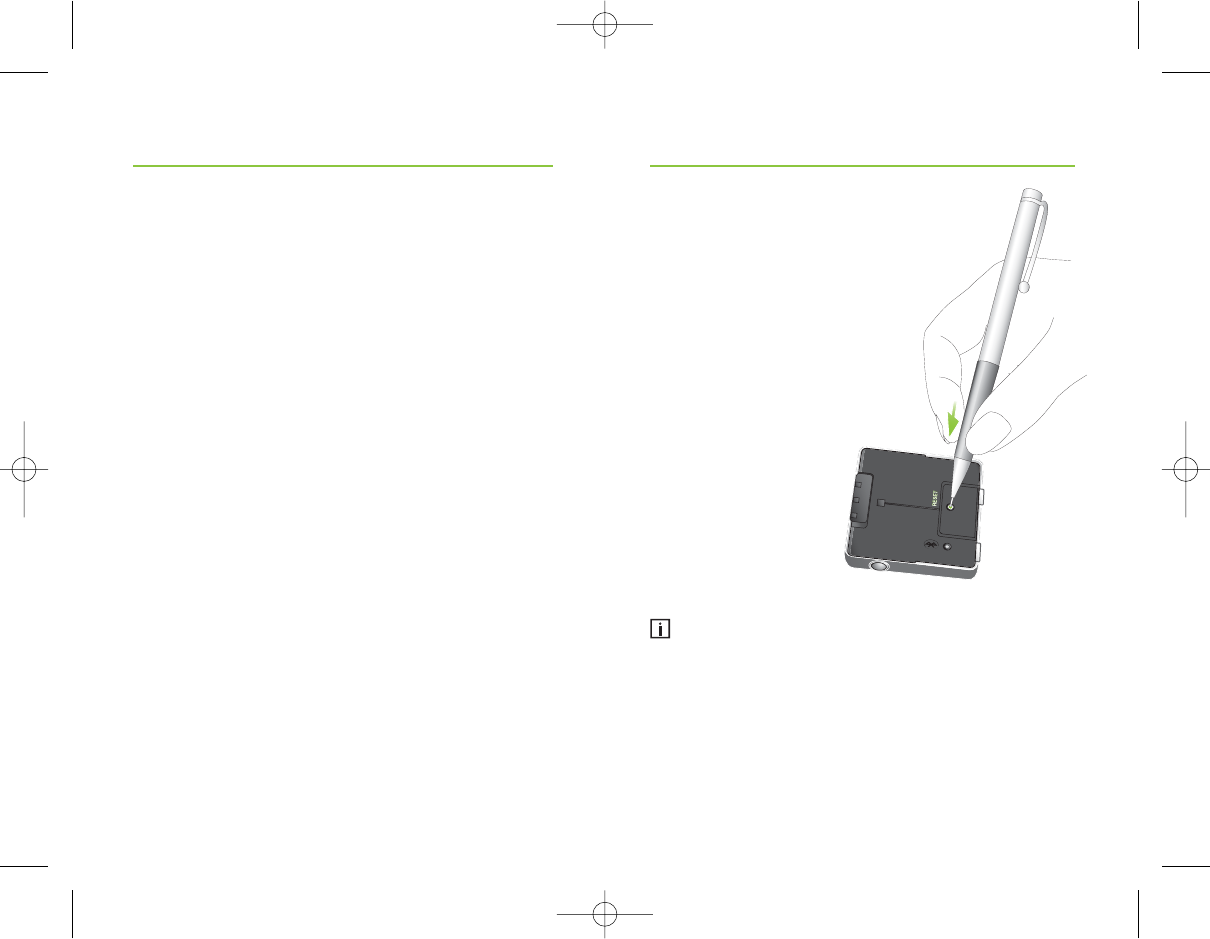
44 45
Using audio devices
Streaming interruptions
Situations where streaming may be interrupted:
• If iCom is too far away from the hearing
instruments while streaming, e.g. if you are not
wearing the neckloop or if you have unplugged
the neckloop cable.
• If the Bluetooth signal is out of range.
In those cases, your hearing instruments will lose the
audio signal. If this situation continues for more than
about 5 seconds, they will automatically switch to the
default hearing program.
To avoid streaming interruptions, make sure you
wear iCom correctly and keep the Bluetooth
device within the operating range as described in
the sections “Wearing iCom” and “Bluetooth link”.
If, for some reason, iCom becomes
unresponsive, press the reset button
on the back of the device as shown
in the picture.
If all three indicators on your iCom are lit solid,
this may indicate a software problem. Refer to
Troubleshooting section.
Reset button
GA_iCom_GB.qxp 4.1.2008 14:12 Uhr Seite 44
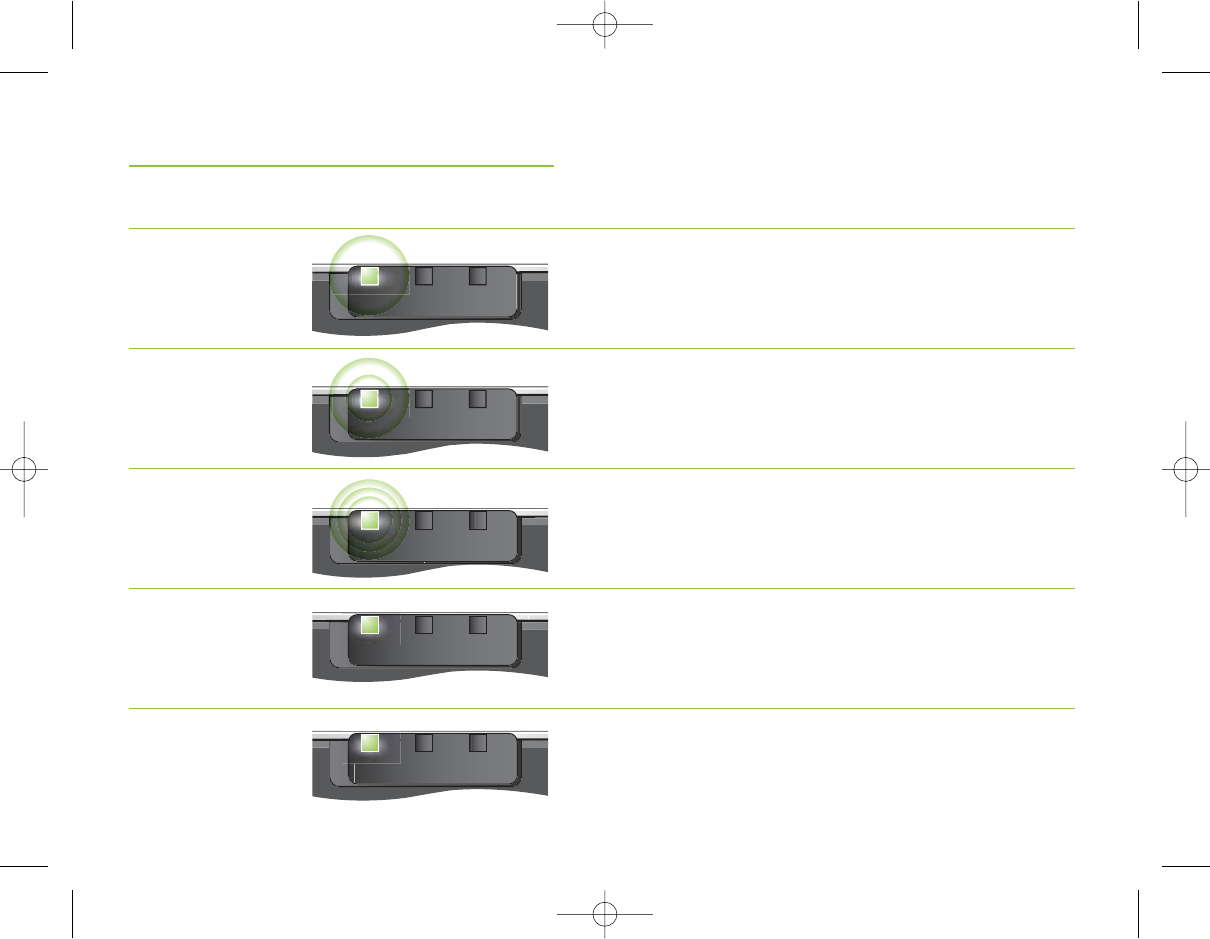
Green
Slow flash
Orange
Medium flash
Red
Fast flash
Orange
Lit solid
Green
Lit solid
Battery full
Battery medium
Battery empty
Battery charging
Battery fully charged
(charger attached)
46 47
Battery indicator
Indicators
GA_iCom_GB.qxp 4.1.2008 14:12 Uhr Seite 46
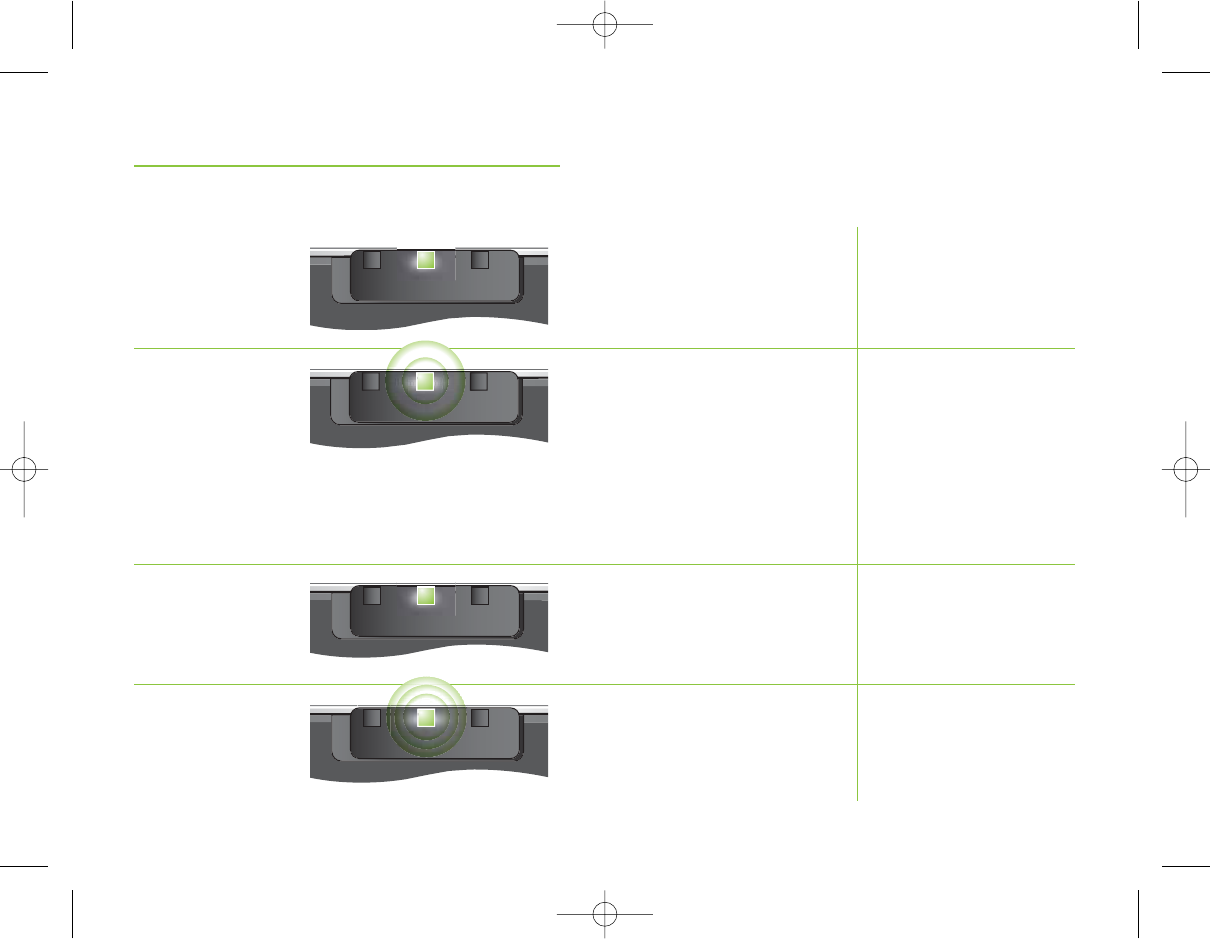
49
48
iCom is streaming
audio to the hearing
instruments.
Audio streaming to
the hearing instruments
is paused. Push the
communication button to
resume.
iCom is in range of
at least one hearing
instrument.
iCom is out of range of
the hearing instruments.
Streaming indicator
Indicators
Yellow
Lit solid
Yellow
Medium flash
Test connection with hearing instruments
Yellow
Lit solid
(for 3 seconds)
Yellow
Fast flash
(for 3 seconds)
Audio streaming
Audio streaming
pause
Good connection
No connection
GA_iCom_GB.qxp 4.1.2008 14:12 Uhr Seite 48
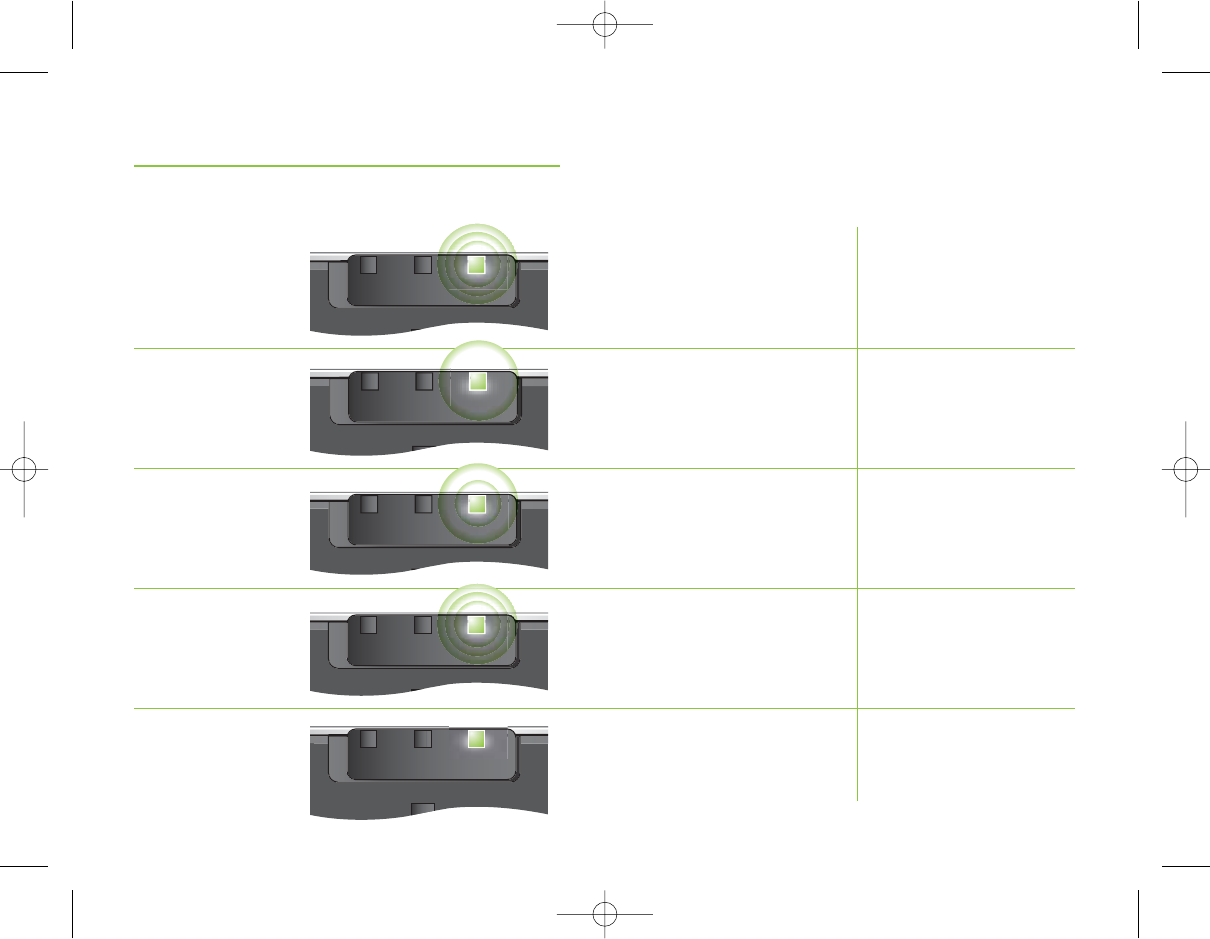
51
50
iCom is in pairing mode
for 2 minutes and
can be detected by other
Bluetooth devices.
At least one device has
successfully connected
with iCom.
Bluetooth transmission
is paused.
A paired and connected
mobile phone is ringing.
iCom is transmitting
Bluetooth signals to the
hearing instruments.
Bluetooth indicator
Indicators
Blue
Fast flash
Blue
Slow flash
Blue
Medium flash
Blue
Intermittent flash
Blue
Lit solid
Bluetooth
Pairing mode
Bluetooth
successfully
connected
Bluetooth
Pause
Bluetooth
Ring
Bluetooth
transmission
GA_iCom_GB.qxp 4.1.2008 14:12 Uhr Seite 50
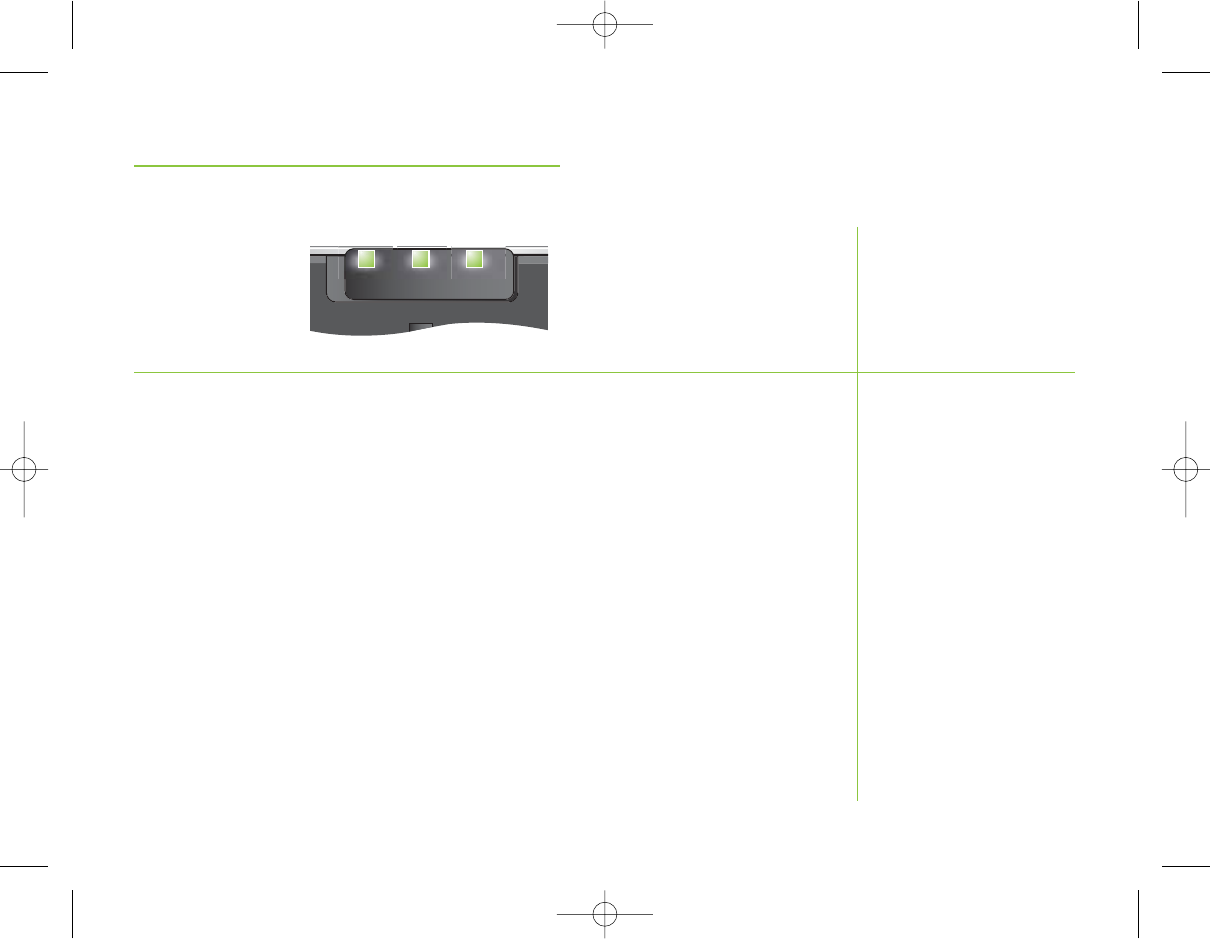
53
52
There may be a software
problem. Refer to
Troubleshooting section.
Error indication
Indicators
All three
indicators
lit solid
Error
GA_iCom_GB.qxp 4.1.2008 14:12 Uhr Seite 52
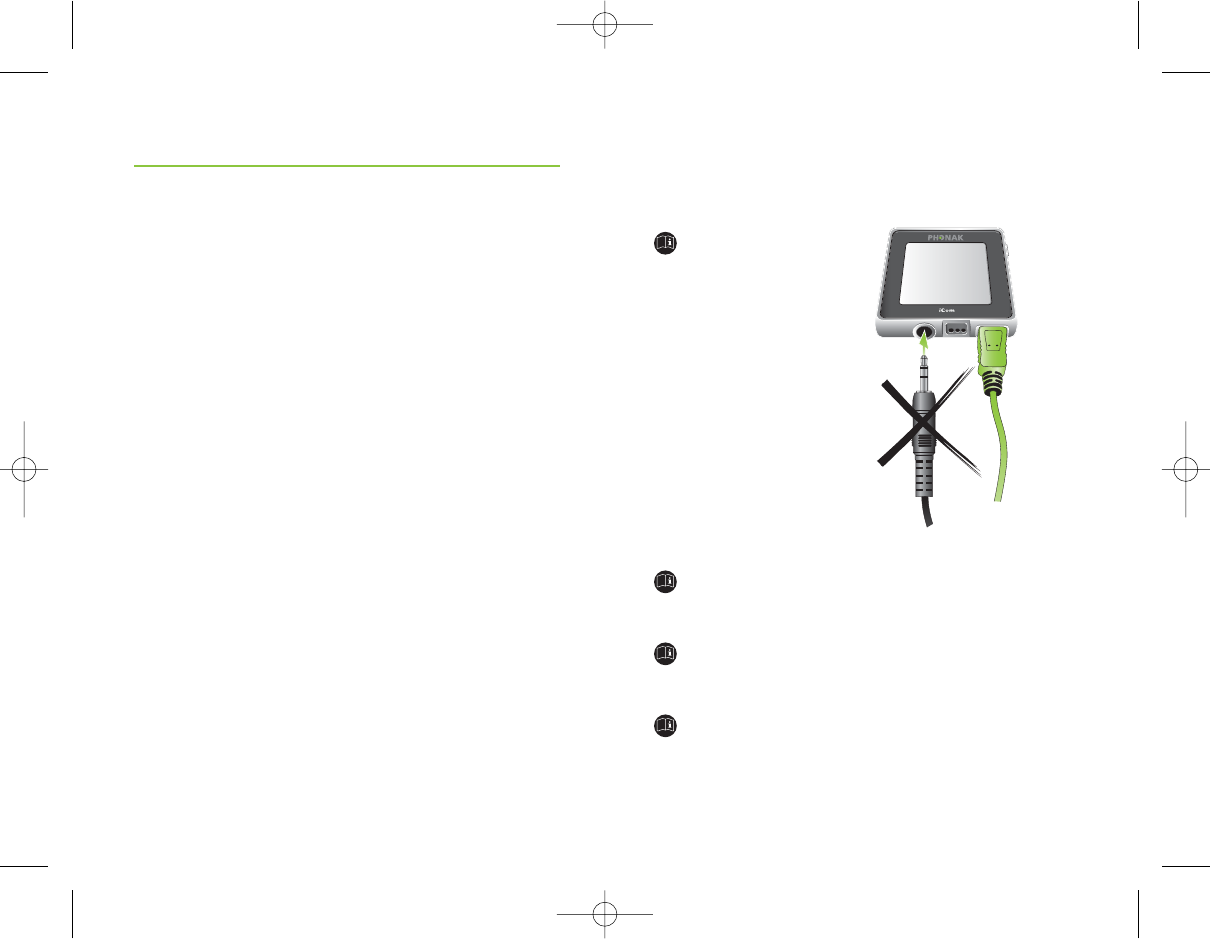
55
54
Safety notice
Do not connect
audio cable ቢ
while USB cable ባ
is connected.
Keep this device out of reach of children under
3 years.
Persons using medical devices such as
pacemakers are not permitted to use this device.
External devices may only be connected if
they have been tested in accordance with
corresponding IECXXXXX standards.
ቢባ
Important information
Maintenance and care
Clean iCom using a damp cloth. Never use household
cleaning products (washing powder, soap, etc.) or
alcohol to clean the device.
When iCom is not in use, turn it OFF and store it
safely.
Protect iCom from excessive moisture (bathing,
swimming) and heat (radiator, car dashboard). Protect
it from excessive shock and vibration.
Protect the microphone openings, connectors for
the audio cable, FM receiver and charger from
dirt and debris. If necessary, use the cleaning brush
provided with your hearing instruments to clean
these areas.
GA_iCom_GB.qxp 4.1.2008 14:12 Uhr Seite 54

57
56
Important points
Do not open the neckloop while iCom is
transmitting signals to your hearing instruments.
The digitally-coded, inductive transmission
technology used in this device is extremely reliable
and experiences virtually no interference from
other devices. It should be noted, however, that
when operating the device near a computer
terminal or other strong electromagnetic fields,
it may be necessary to be at least 60cm (24”)
away to ensure proper operation.
Do not use this device in locations where it is
forbidden to use electronic devices, for instance
on airplanes.
X-ray radiation (e.g. CT scans, MRI scans) may
adversely affect the correct functioning of
this device. We recommend that you switch the
device OFF before undergoing X-ray procedures
and keep it outside the room.
High-powered electronic equipment, larger
electronic installations and metallic structures
may impair and significantly reduce the
operating range.
If the hearing instruments do not respond to
the device because of an unusual field
disturbance, move away from the disturbing field.
Your hearing instrument(s) and this device were
given a unique communication code during the
fitting. This ensures that the device will not affect
hearing instruments worn by others.
When using an FM transmitter, be aware
that radio signals might also be picked up and
overheard by other receivers.
Before using the system in another country,
contact your hearing care professional to make
sure your radio channels are permitted in that
country.
Use only original Phonak accessories.
Important information
GA_iCom_GB.qxp 4.1.2008 14:12 Uhr Seite 56

59
58
Do not make any changes or modifications to
this device.
Opening iCom might damage it. If problems occur
which cannot be resolved by following the remedy
guidelines in the troubleshooting section of this
user guide, consult your hearing care professional.
iCom may only be repaired by an authorized
service center.
The battery may only be replaced by an authorized
service center.
Important information
GA_iCom_GB.qxp 4.1.2008 14:12 Uhr Seite 58

61
60
Troubleshooting
Situation
iCom is no longer
recognized by the mobile
phone or other Bluetooth
device to which it
was previously paired.
The mobile phone is
ringing but the Bluetooth
indicator is not flashing
and there is no ringing
indication in the hearing
instruments.
Remedy
Repeat the pairing between iCom and the Bluetooth
device which was overwritten.
Ensure Bluetooth is turned ON in the mobile phone.
Please refer to your mobile phone’s user guide.
1. Disable the Bluetooth functionality in your mobile
phone and turn it ON again.
2. Restart iCom by turning it OFF and back ON. The
iCom’s Bluetooth functionality will be automatically
re-activated.
3. Activate iCom by selecting it in the mobile phone’s
“Active device” menu. Reduce the distance between
iCom and the mobile phone.
Follow the pairing process as described on page 22.
Most probable cause
iCom can be paired to a
maximum of 8 different
Bluetooth devices.
If the internal memory
is full, new pairings
will overwrite previous
pairings.
Bluetooth is OFF in the
mobile phone.
iCom and your mobile
phone are not connected
to each other.
iCom is not paired to the
mobile phone.
Important information
GA_iCom_GB.qxp 4.1.2008 14:12 Uhr Seite 60

63
62
Troubleshooting
Situation
The mobile phone is
ringing, the Bluetooth
indicator is flashing
but there is no ringing
indication in the hearing
instruments.
When making phone calls
the other party reports
difficulties hearing me.
I hear my mobile phone’s
key-press tones in
my hearing instruments.
The volume of phone
conversations, audio
streaming and FM
connections is not
comfortable (too low
or too high).
Remedy
Make sure you wear iCom around your neck.
Make sure the microphone openings are not
covered and that you speak into iCom as shown on
page 31. Do not turn iCom sideways as you
speak. Be careful not to let iCom rub against clothing.
Deactivate key-press and confirmation tones on
your mobile phone. Please refer to the mobile phone
user guide.
Volume cannot be changed via iCom. Adjust the
volume on the connected audio source or
mobile phone or change the volume on the hearing
instruments.
Most probable cause
iCom is out of range of
the hearing instruments.
The iCom’s microphone
openings may be covered
or not able to pick up
your voice correctly.
The key-press tones
may be ON in your mobile
phone.
The different audio sour-
ces have different output
volumes.
Important information
GA_iCom_GB.qxp 4.1.2008 14:12 Uhr Seite 62

65
64
Troubleshooting
Situation
iCom is unresponsive
and all three indicators
are lit solid.
Remedy
Unplug any connectors on the iCom, including the
USB charging connector, and press the reset button.
If the problem persists, delete Bluetooth pairings
and press the reset button again. If the problem still
persists, please contact your hearing care
professional.
Most probable cause
This may indicate a
software problem.
Important information
GA_iCom_GB.qxp 4.1.2008 14:12 Uhr Seite 64
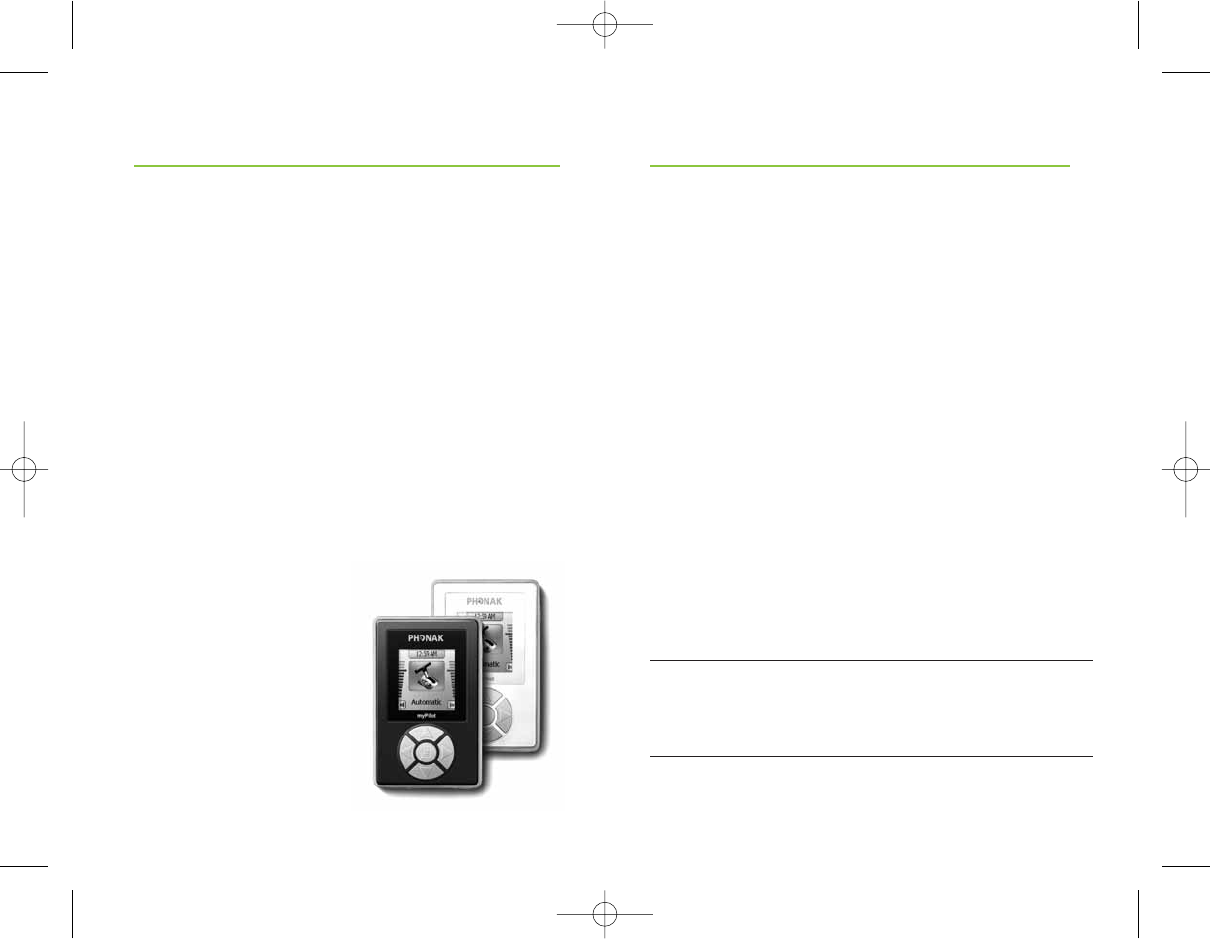
67
66
myPilot (optional)
The myPilot comand center is another important
accessory of your hearing system. It allows a
convenient, user-friendly and discrete control of all
the functions of your hearing system and additional
benefits.
• Volume Control
• Program selection
• Automatic mode selection
• Access to ZoomControl program
• Clock and alarm
• Battery status
For detailed information on the use of your myPilot,
please refer to its user guide or ask your hearing
care professional or
refer to its user guide.
myPilot:
available in two
stylish colors,
high-tech grey or
white.
Phonak offers you a comprehensive global warranty
which becomes effective on the date of purchase.
Please ask your hearing care professional about the
details and duration. This warranty covers any repairs
due to defects in material and/or workmanship. The
warranty does not cover damage from improper
handling or care, exposure to chemicals, immersion
in water or undue stress. Damage caused by third
parties or non-authorized service centers renders the
Phonak warranty null and void. This warranty does
not include any services performed by a hearing care
professional in their office. This warranty applies to
the Phonak products listed below:
Serial number:
Date of purchase:
Service and Warranty
GA_iCom_GB.qxp 4.1.2008 14:12 Uhr Seite 66

69
68
Phonak AG, Laubisrütistrasse 28, CH-8712 Stäfa,
Switzerland declares under its sole responsibility that
iCom is in conformity with the following standards
or other standardizing documents:
Radio: EN 300-330
EN 300 328
EMC: EN 60601-1-2
Safety: EN/IEC 60601-1
Implementing the provisions of the MDD 93/42/EEC
(Medical Device Directive), R&TTE Directive 1999/5/EC
(Radio and Telecommunications Terminal Equipment),
EMC Directive 2004/108/EC (Electromagnetic
Compatibility) and LVD 2006/95/EC (Low Voltage
Directive).
Declaration of conformity
GA_iCom_GB.qxp 4.1.2008 14:12 Uhr Seite 68

71
70
Spain Phonak Ibérica S.A., 03008 Alicante
Sweden Phonak AB, 117 43 Stockholm
Switzerland Phonak AG, Phonak Schweiz, 8712 Stäfa
United Kingdom Phonak UK Limited
Warrington, Cheshire WA1 1PP
USA Phonak LLC, Warrenville, IL 60555-3927
Independent general A complete list of Phonak distributors
distributors: is available at Phonak's Internet site:
www.phonak.com. Please visit us or
ask your hearing care professional for
information.
Manufacturer: Phonak AG, Laubisrütistrasse 28
CH-8712 Stäfa, Switzerland
Phonak distributors worldwide
Group companies: (detailed information on
www.phonak.com)
Australia Phonak Australasia Pty. Ltd.
Baulkham Hills N. S. W. 2153
Austria Hansaton Akustische Geräte GmbH
5020 Salzburg
Belgium Ets Lapperre B.H.A.C. NV
B-1702 Groot-Bijgaarden
Phonak Belgium NV, B-1700 Dilbeek
Brazil CAS Produtos Médicos
São Paulo – SP 04363-100
Canada Phonak Canada Limited
Mississauga, Ontario L5S 1V9
China Phonak (Shanghai) Co. Ltd.,
Shanghai City 200233
Denmark Phonak Danmark A/S, Nitivej 10
2000 Frederiksberg
France Phonak France SA, 69500 Bron
Germany Phonak GmbH, 70736 Fellbach-Oeffingen
EC Representative
Italy Phonak Italia S.r.l., 20159 Milano
Japan Phonak Japan Co., Ltd., Tokyo 101-0044
Jordan Phonak Middle East, 11181 Amman
Mexico Phonak Mexicana, S.A. de C.V. 03920
México, D.F.MEXICO
Netherlands Phonak B.V., 3439 ME Nieuwegein
New Zealand Phonak New Zealand Ltd., Takapuna
Auckland 9
Norway Phonak AS, 0105 Oslo
Poland Phonak Polska Sp. z o.o., 00-567 Warszawa
Russian Federation Phonak CIS Ltd., Moscow, 115114
GA_iCom_GB.qxp 4.1.2008 14:12 Uhr Seite 70
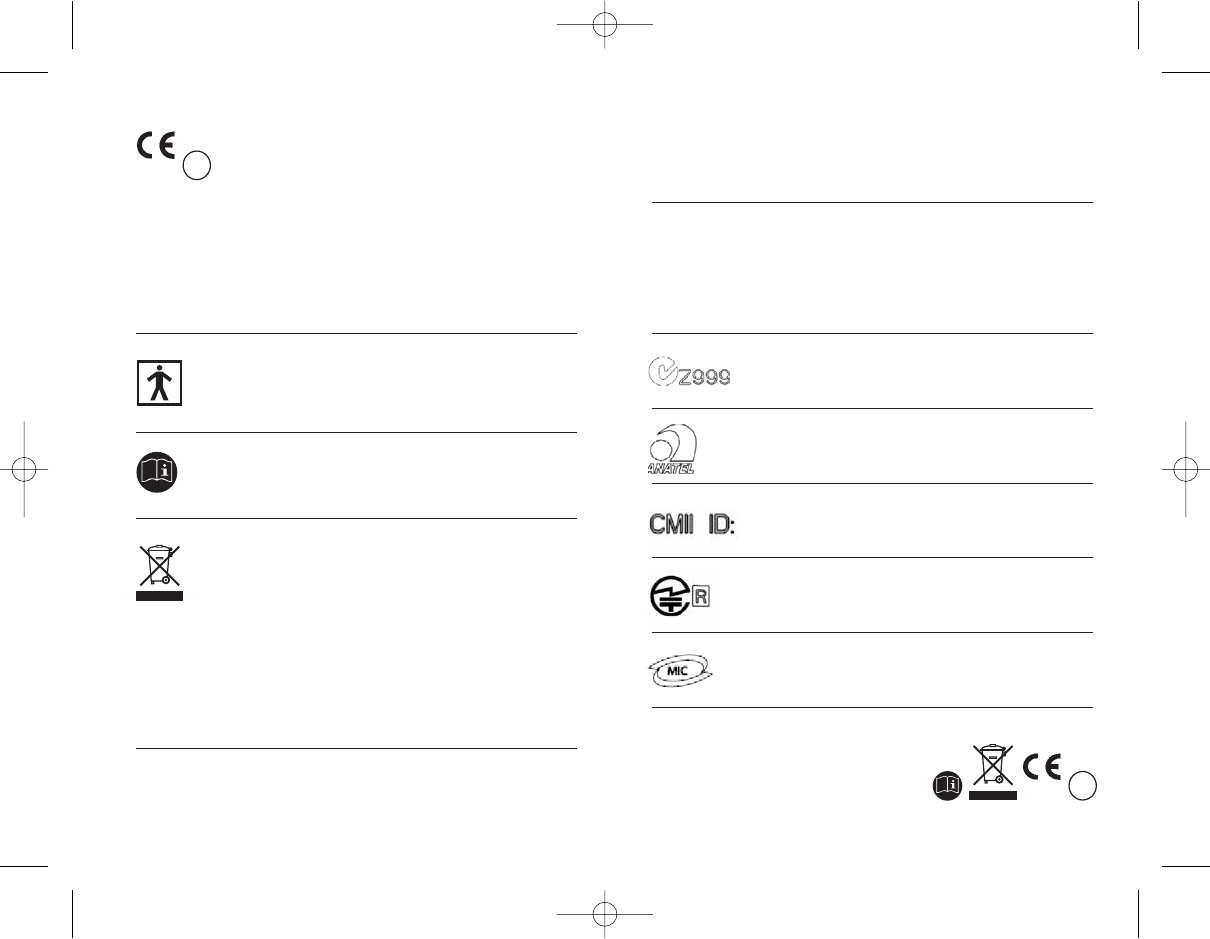
73
72
The CE symbol is confirmation by Phonak AG that
this Phonak product meets the requirements
of directive 93/42/EEC on medical devices and the
R&TTE Directive 1999/5/EC on Radio and
Telecommunication Terminal Equipment.
The numbers after the CE symbol are the numbers
of consulted certified bodies under the above
mentioned directives. The alert sign means that
potential restrictions on its use are applicable
in one or more EU Member States.
This symbol indicates this product complies with
requirements for a BF type applied part according to
EN 60601-1.
This symbol indicates that it is important that the user
refers to associated warnings given in this user guide.
The symbol with the crossed out disposal bin indicates
that this product shall not be treated as household
waste. Please hand over your old or unused product to
the applicable collection point for the recycling of
electrical and electronic equipment or bring your old
product to your hearing care professional for
appropriate disposal. By ensuring this product is
disposed of correctly, you will help prevent potential
negative effects on the environment and human
health.
Operating This product has been designed for trouble-free
conditions operation without restrictions when used as intended,
unless otherwise stated in this user guide.
Transportation Temperature should not exceed limits of –20°/60°
and storage Celsius at a relative air humidity of 65% for extended
conditions periods during transportation and storage.
Air pressure between 500 and 1100 hPa is not
detrimental to this device.
Australia & New Zealand
Brazil
China
Japan
South Korea
XXXX !
0682 !
GA_iCom_GB.qxp 4.1.2008 14:12 Uhr Seite 72

75
74
Notice 3
This equipment has been tested and found to comply
with the limits for a Class B digital device, pursuant to
Part 15 of the FCC Rules.
These limits are designed to provide reasonable
protection against harmful interference in a residential
installation. This equipment generates, uses, and can
radiate radio frequency energy and, if not installed and
used in accordance with the instructions, may cause
harmful interference to radio communications. However,
there is no guarantee that interference will not occur
in a particular installation.
If this equipment does cause harmful interference to
radio or television reception, which can be determined
by turning the equipment off and on, the user is
encouraged to try to correct the interference by one or
more of the following measures:
• Reorient or relocate the receiving antenna
• Increase the separation between the equipment
and receiver
• Connect the equipment into an outlet on a
circuit different from that to which the receiver is
connected
• Consult the dealer or an experienced radio/TV
technician for help
Notices
Notice 1
This instrument is certified under:
FCC ID: KWC-ICOM1
IC: 2262A-ICOM1
This device complies with Part 15 of the FCC Rules
and with RSS-210 of Industry Canada. Operation is
subject to the following two conditions:
1) this device may not cause harmful interference, and
2) this device must accept any interference received,
including interference that may cause undesired
operation.
Changes or modifications made to this equipment
not expressly approved by Phonak may void the FCC
authorization to operate this equipment.
Notice 2
This Class B digital apparatus complies with Canadian
ICES-003.
GA_iCom_GB.qxp 4.1.2008 14:12 Uhr Seite 74